Long before the catholic church and related christian religions started declaring beer and brewing saints, many different civilizations and peoples had deities dedicated to beer or brewing, or some related endeavor. Below is a list of the beer gods and goddesses that I know of, along with other mythological creatures or people with an association to beer, brewing or a related aspect. Try as I might, I couldn’t find any gods or goddesses associated with either hops or yeast specifically, probably because by the time we were using them in beer, or had a better understanding of them, civilization was well past creating gods. Perhaps we need to make some up? There are also many more deities associated with water, but it’s unclear if any of them can be linked to brewing water, and many are gods of the sea, which also didn’t seem appropriate. So far, I’ve found over 100 different deities to drink a toast to, celebrate or worship with a glass of beer. If you know of one I’m missing, please drop me a line.
Alphabetical List of Beer Gods & Goddesses
-
- Abundantia: Roman Goddess of Abundance; See Habonde.
-
- Acan: Mayan God of Alcohol
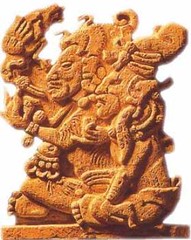
Acan is the Mayan God of Alcohol (or intoxicating beverages), whose name means literally “groan.” He’s said to be very boisterous and often makes a fool of himself while intoxicated.
Holiday: Feast of Acan, April 2
Links: Godchecker / Wikipedia
- Acan: Mayan God of Alcohol
-
- Accla: Incan female keepers of the sacred fires, who also brewed beer
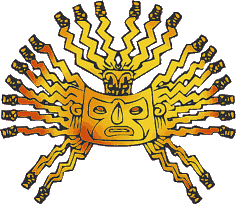
The Accla were female virgins chosen by Inti (The Incan Sun God) to keep the sacred fires burning. In their spare time, they also brewed beer.
Holiday: Inti Raymi (Festival of the Sun), June 24
Links: Godchecker / Wikipedia
- Accla: Incan female keepers of the sacred fires, who also brewed beer
-
- Aegir: Norse Brewer to the Gods of Asgard
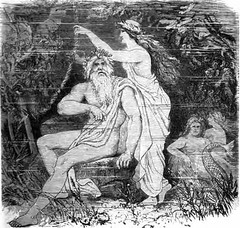
Aegir (sometimes spelled Oegir) was primarily the Norse God of the Sea, but was also the brewer to the Gods of Asgard. He and his nine daughters (the billow maidens) brewed ale in a large pot given to Aegir by Thor. His association to brewing is most likely due to the foam on the ocean looking similar to the foamy head of an ale. Aegir was also a terrific host. The mugs in his house refilled themselves with more ale when you drained your cup so your never went thirsty.
Holiday: Celtic Sea Festival, March 3
Links: Godchecker / Wikipedia
- Aegir: Norse Brewer to the Gods of Asgard
-
- Aizen Myō’ō: Japanese God of Tavern Keepers
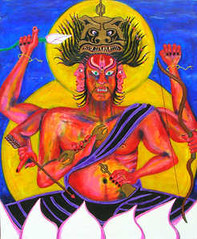
Aizen Myō’ō is the Japanese god of tavern keepers, musicians, singers, prostitutes and love. He’s a Buddhist deity and in Chinese Buddhism he’s known as Rāgarāja
Holiday: Aizen Festival in Osaka, Japan, June 30-July 2
Links: Godchecker / Wikipedia
- Aizen Myō’ō: Japanese God of Tavern Keepers
-
- Albina: Arcadian, British & Irish White Barley Goddess

The White Barley Goddess, Albina was also known as Alphito. One of the earliest names for the British Isles, Albion, is thought to come from her name. The first modern microbrewery in the U.S. was called “New Albion Brewing.”
Holiday: Festival of Albina, a.k.a. Alphito, August 1
Links: Wikipedia
- Albina: Arcadian, British & Irish White Barley Goddess
-
- Amaethon: Welsh God of Agriculture
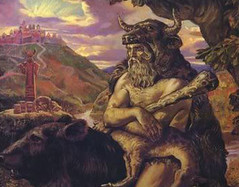
Amaethon was the god of agriculture, and the son of the goddess Dôn. His name means “laborer” or “ploughman.” He apparently was “responsible for the Cad Goddeu, or “Battle of Trees,” between the lord of the otherworld, Arawn, and the Children of Dôn, and the tale is essentially the Welsh version of the Tuatha Dé Danann
Holiday: Alban Elfed, September 22 (Autumnal Equinox)
Links: Godchecker / Wikipedia
- Amaethon: Welsh God of Agriculture
-
- Arnemetia: Celtic River Goddess

Arnemetia was a river goddess who was worshiped in Roman times at Aquae Arnemetiae, the present-day Buxton Spa. Her name is connected with nemeton, “sacred grove,” which I want to believe means it’s the best place to find brewing water.
Holiday: Festival of Sacred Groves, April 21
Links: Godchecker / Wikipedia
- Arnemetia: Celtic River Goddess
-
- Ashnan: Mesopotamian/Sumerian Goddess of Grain
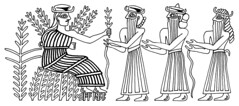
Ashnan, or Asnan, was a goddess of grain in Mesopotamia, and a goddess of drunkenness, wine & grains in Sumeria. “She and her brother Lahar, God of cattle, were created by Enlil to provide food for the Gods. One day they had too much to drink and could not serve as they should, so Enlil decided to create humans to serve the Gods instead. Ashnan was often shown with ears of corn sprouting from her shoulders.” Like most grain goddesses, Ashnan was a very old deity; she appeared in the Early Dynastic period (2900-2350 B.C.E.)
Holiday: Mesopotamian/Sumerian Grain Festival, March 20
Links: An Inner Journey / Wikipedia
- Ashnan: Mesopotamian/Sumerian Goddess of Grain
-
- Bacchus: Roman God of Intoxication; See Dionysus.
-
- Ba-Maguje: Hausa Spirit of Drunkenness
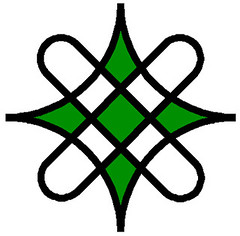
In Hausa mythology, Ba-Maguje is the spirit of drunkenness. There’s no physical description of Ba-Maguje, but he supposedly causes alcoholism by making people increasingly thirsty but insensitive the how much they’ve consumed. The Hausa are Muslims living in northern Nigeria and other parts of West Africa.
Holiday: Ba-Maguje’s Day (on Eid al-Fitr; July 28, 2014)
Links: Mythology Dictionary / Wikipedia
- Ba-Maguje: Hausa Spirit of Drunkenness
-
- Bes: Proto-Egyptian God, Protector of the Home
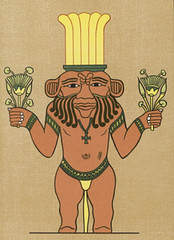
This deity originated in the Sudan and is represented as a grotesque, bearded dwarf with a crown and a sword. Bes, was also a primary god of women in labor and a protector of the home, but it was his fondness for beer that established a spiritual association for brewing second only to that of the goddess Hathor. According to Ian Spencer Hornsey’s A History of Beer and Brewing, “Bes was very fond of drinking beer and is often represented on scarabs as sucking beer through a straw from a large vessel.” In addition, “Soldiers were known to drink beer from Bes-shaped mugs as a deterrent to injury in battle.”
Holiday: Festival of the Little Heat, December 16
Links: Godchecker / Wikipedia
- Bes: Proto-Egyptian God, Protector of the Home
-
- Bhairava: Indian God of Soma

Bhairava, or Bharani, was the Hindu god of misfortune, and “is the fierce manifestation of Lord Shiva associated with annihilation.” I’ve listed him here because of a story told by Sherbrooke Liquor Store:This is an aspect of the Hindu god Shiva, however the one with a nasty temper. Legend has it that Shiva couldn’t handle the idle boasting of Brahma claiming to be the supreme creator, and cut off one of his 5 heads in order to make a point. After, when cooler heads prevailed, Shiva made a remorseful vow of redemption, and was cast out as a beggar under the new guise of Bhairava. He also had the skull of the decapitated head fused to his hand to use as a begging bowl, and a reminder for anger management. Oddly enough the Newar culture of the Kathmandu valley have a unique festival where they set up a large mask of Bhairava to dispense beer from its mouth. This beer is considered sacred, and bestows powerful blessings on whoever manages to get a sip of it.
Holiday: Bhairava Ashtami, 8th lunar day (ashtami) in the fortnight of the waning moon (Krishna paksha) in the Hindu month of Kartik (November 23, in 2013)
Links: Godchecker / Wikipedia
- Bhairava: Indian God of Soma
-
- Biersal: Germanic Kobold of the Beer Cellar
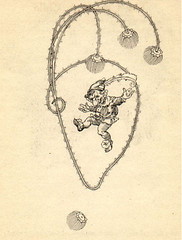
Biersal (or sometimes Bierasal or Bieresal) is a kobold of the beer cellar. A kobold (or cobold) “is a sprite stemming from Germanic mythology and surviving into modern times in German folklore. Although usually invisible, a kobold can materialize in the form of an animal, fire, a human being, and a candle. The most common depictions of kobolds show them as humanlike figures the size of small children. Kobolds who live in human homes wear the clothing of peasants.” If he is appeased by a daily jug of beer, this spirit of the cellar will clear all the bottles and jugs.Domestic kobolds are linked to a specific household. A bieresal, kobolds who live in the beer cellars of inns, bring beer into the house, clean the tables, and wash the bottles and glasses. This association between kobolds and work gave rise to a saying current in 19th-century Germany that a woman who worked quickly “had the kobold.” In return, the family must leave a portion of their supper (or beer, for the bierasal) to the spirit and must treat the kobold with respect, never mocking or laughing at the creature. A kobold expects to be fed in the same place at the same time each day. Kobolds bring good luck and help their hosts as long as the hosts take care of them.
I’m not sure, but it sounds like kobolds are mischievous little creatures, and I wouldn’t be surprised they were related to leprechauns.
Holiday: Kobold Luring Day, December 27
Links: Encyclopedia Mythica / Wikipedia
- Biersal: Germanic Kobold of the Beer Cellar
-
- Byggvir: Norse God of Barley
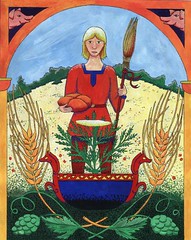
Byggvir is the Norse God of Barley and his wife Beyla is said to do things with bees and barley, most likely make beer.
Holiday: Byggvir Grain Festival, December 14
Links: Godchecker / Wikipedia
- Byggvir: Norse God of Barley
-
- Centzon-Totochtin: The Aztec Four Hundred Drunken Rabbit Gods
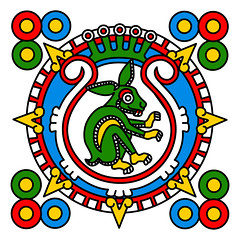
The Centzon-Totochtin are the “Four Hundred Drunken Rabbit Gods,” which according to legend were brewed by the married couple deities Mayahuel (Goddess of Alcohol, though more on the other of Tequila) and Petecatl (God of Medicine). The rabbits represented the infinite ways that people can be affected by intoxication. In the early Aztec numbering system, 400 represented infinity. Their King, Ometotchtli was also known as “Two Rabbit.” Macuiltochtli was another Aztec God of Alcoholic Beverages, and he was also known as “Five Rabbit.” Curiously, there was no “One Rabbit.”
Holiday: Centzon-Totochtin Drunken Rabbit Day, Last Saturday in September (28th in 2013); Rabbit Rabbit Day, Last Day of Each Month
Links: Godchecker / Wikipedia
- Centzon-Totochtin: The Aztec Four Hundred Drunken Rabbit Gods
-
- Ceres: Roman Goddess of Agriculture & Grain Crops
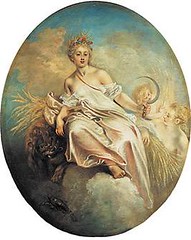
Above all, Ceres was a “mother goddess” and one of the most important to the Romans. In Greek, where she was called “Demeter,” her name means “mother earth” or “barley-mother.” As such, she was also the Goddess of Agriculture and of the harvest. The Spanish word for beer, “cerveza” is taken from her name.
Holiday: Sementivae begins (Ancient Roman Festival honoring Ceres and Tellus), January 24; Cerealia, April 19; Festival of Kore and Demeter (Persephone Greek Vegetation Goddess and Barley Mother Goddess), March 21; Festival of Demeter (Greek Barley Mother Goddess), May 21; Ambarvailia (Old Roman No Work Day, Purification Festival to Ceres), May 29; Feast of Ceres, September 18; Thesmophoria (honoring the goddesses Demeter and her daughter Persephone), October 25-27 (originally 11-13 Pyanepsion)
Links: Godchecker / Wikipedia
- Ceres: Roman Goddess of Agriculture & Grain Crops
-
- Cerklicing: Latvian God of Farm Fertility and Crop Abundance
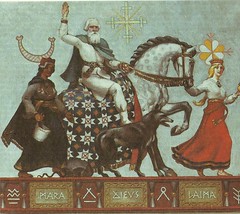
Cerklicing was a Latvian agricultural deity of farm fertility and crop abundance. His job was protecting the fields, taking corn and beer in payment for livestock and shares. Apparently “among Latvian farmers he was more popular than Jesus, at least for a time.” According to the Jesuit Joannis Stribingius, Latvian farmers gave the “first bite of any food, and the first drop of any drink” to Cerklicing when he visited eastern Latvia in 1606. I couldn’t find any image of Cerklicing, so these are a few other Latvian deities.
Holiday: Līgo, June 23
Links: Godchecker / Wikipedia
- Cerklicing: Latvian God of Farm Fertility and Crop Abundance
-
- Cerridwen: Welsh Goddess of Barley
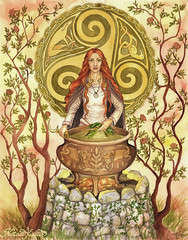
Cerridwen was the Irish and Welsh Barley Goddess. She also owned the “witches” cauldron of inspiration, which presumably she filled with barley to make beer, known as the “Brew of Inspiration and Knowledge.”
Holiday: Festival of Cerridwen, July 3; Day of Cerridwen and Her Cauldron, June 20; Day of Cerridwen, October 21
Links: Godchecker / Wikipedia
- Cerridwen: Welsh Goddess of Barley
-
- Cluricane: Irish Spirit or Elf
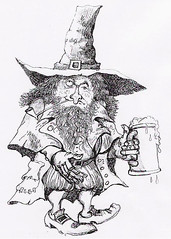
An Irish spirit or elf. This being, looking like a very old man, lives in the cellar taking care of the beer, etc. It is said to know the location of hidden treasures. The spirit is known by many different names, including cluricane, cluracan, cluracan, clurican, clurican, Cluricaune, Cluricaune, Cluricane, leprechaun, leprechaun, leprachaun, leprecawn, leprechawn, lepricaune, lubberkin, lubrican, luprachain, leprec(h)awn, luchorpain, cluricaune or cluricaune. Some accounts say they’re the same as leprechauns while many others say instead that they’re cousins, or at least related.
Holiday: Leprechaun Day, May 13
Links: Mystical Myth / Wikipedia
- Cluricane: Irish Spirit or Elf
-
- Comus: Greek God of Drunken Revelry
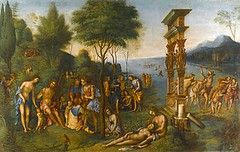
Comus, sometimes Komos, was the “son and a cup-bearer of the god Bacchus.” He was the Greek god of comedy, jokes and drunken revelry, and also is considered the “god of excess.”
Holiday: Feast of Comus, May 27.
Links: Godchecker / Wikipedia
- Comus: Greek God of Drunken Revelry
-
- Consus: Roman Protector of Grains and Storage Bins
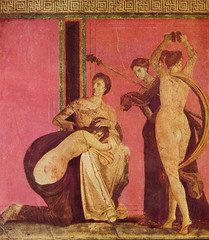
Consus was a Roman god whose job was as the protector of grains and storage bins. He was apparently “represented by a grain seed.” Consus may also have been a harvest gods, and was “associated with secret conferences,” too.
Holiday: Consualia (or Consuales Ludi), August 21 and December 15 (Consus had two festivals each year)
Links: Godchecker / Goddesses and Gods / Wikipedia
- Consus: Roman Protector of Grains and Storage Bins
-
- Crom Dubh: Irish Underworld Grain or Corn God
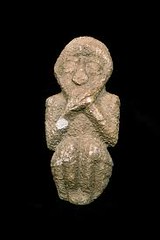
Crom Dubh is the “dark bent” god of the harvest, associated with grain or sometimes corn. He is associated with the god Lugh (as his dark counterpart) and connected to the festival of Lammas; and also is connected to John Barleycorn (see John Barleycorn below), the personification of the grain, who is killed by being harvested at this time. Many people honor St. Patrick’s Fast by making a pilgrimage to Croagh Patrick, where he fasted until he overcame the pagan deity Crom Cruach (Crom of the Reek). Other names he’s known by include Crom Crúaich, Cromm, Cróich, Crooach, Cruach, Cenn Cruach, Kerman Kelstach, and Kerum Kerugher.
Holiday: Domhnach Chrom Dubh (Grain Festival, Last Sunday in July / Dé Domhnaigh Crum-Dubh (a.k.a. Crom Dubh Sunday), 1st Sunday in August
Links: Africa Source / Confessions of a Hedge Witch / Pagan Pages / Wikipedia
- Crom Dubh: Irish Underworld Grain or Corn God
-
- The Dagda: Celtic God of the Earth & All-Father

The Dagda was the Irish, and Celtic, God of the Earth and All Father, which is why’s also referred to as Eochaid(h) or Ollathair, which means “all-father.” He’s also the God of Life and Death, War, Banquets and Magic. His name, The Dagda, means “the good god” or “the good one” and he’s one of the most prominent Irish gods and the leader of the Tuatha Dé Danann. Dagda is a son of the goddess Danu, and father of the goddess Brigid and the god Aengus mac Oc. The Morrigan is his wife, with whom he mates on New Years Day. He also owns a huge “cauldron with an inexhaustible supply of food,” “an enormous club, with one end of which he could kill nine men, but with the other restore them to life,” two magic swine — one that’s constantly roasting and one that never stops growing — and fruit tree that alwats has fruit and “a magical harp with which he summons the seasons.”Here’s the Irish Legend of the Dagda’s Harp:
Long ago, the Tuatha de Danaan, supernatural beings, blond and blue-eyed and carrying heavy spears, came from the north to the land known as Ireland. When their king, Nuada, was injured in battle, a man called the Dagda became their new leader.
Like his people, the Dagda possessed magical gifts learned in the northern lands, and though he could sometimes be oafish or silly, he was also a man of immense power and goodness. Among his many possessions were a magic club and a cauldron of abundance known as Undry; this cauldron was a bottomless source of life.
Even more amazing than the Undry was his magical harp. It was among the Dagda’s most cherished possessions, hewn of oak and encrusted with jewels and gold. The harp held exquisite, commanding music. Simply by plucking its strings, the Dagda could create many wonders. He could put the seasons in order; when it was time to fight his enemies, the Dagda plucked the strings of that harp and every warrior was instantly ready for battle, prepared to defend their people.
It wasn’t only a call to battle the Dagda could play upon that harp. When his warriors returned from battles, the Dagda played his harp again. This time the magic music soothed every wound. Men forgot their injuries and their sorrows. They let every woe vanish in the mist. As the music of healing played, the warriors thought not of suffering but of honor and of the love they had for their children and wives and for their friends lost to battle. They remembered glory. They celebrated their king.
And it’s the harp that provided the inspiration for the stringed symbolism so prominent in Irish history, including the Irish coat of arms and the Guinness logo. Although the actual harp was owned by Brian Boru, Ireland’s king from 1002–1014, and today is at Trinity College, Dublin. The Guinness harp faces right instead of left, so it “can be distinguished from the Irish coat of arms.” But all this Harpiness can be traced back to The Dagda.
Holiday: Imbolc (Feast of Brigid), February 1; Féile Pan Cheilteach (or Pan Celtic Festival), April 2-7 (Week after Easter); Guinness Brewery founded, December 31 (1759)
Links: Godchecker / Tell Me A Story / Wikipedia
- The Dagda: Celtic God of the Earth & All-Father
-
- Dagon: Phoenician God of Wheat & Grain
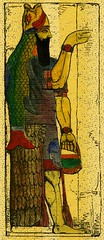
Dagon is the Phoenician god of wheat and grain. Confusingly, it’s sometimes spelled Dagan, but there’s also another god by that same name, who is different from Dagon.
Holiday: Festival of Dagon, on April 18, in 2014; Good Friday [Friday before Easter]
Links: Godchecker / Wikipedia
- Dagon: Phoenician God of Wheat & Grain
-
- Demeter: Greek Goddess of Agriculture & Grain Crops; See Ceres.
-
- Dionysus: Greek God of Intoxication

We think of Dionysus today as the God of Wine, but he was also the God of Intoxication, including beer, and more importantly its social and beneficial aspects. As such, Dionysus is also a promoter of civilization, a lawgiver and lover of peace. But there’s also a story that before Dionysus was the God of Wine, he had been the God of Beer under the name “Sabzios.” As wine become more important in Greek society, he simply changed his name and his affiliation.
Holiday: Anthesteria, January 12; Lenaia (Festival of Drama), February 1; Feast of Bacchus, March 15; Dionysia, March 21; Oschophoria (Autumn Dionysus Festival), October 1; Brumalia begins (Roman feast of Bacchus), November 24
Links: Godchecker / Wikipedia
- Dionysus: Greek God of Intoxication
-
- Dís: Norse Female Ghost, Spirit or Deity Associated with Fate
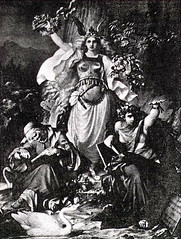
Dísablót is a holiday honoring the ancient Goddess Dís, or collectively the Dísir. Wikipedia refers to them as a “ghost, spirit or deity associated with fate who can be both benevolent and antagonistic towards mortal people. Dísir may act as protective spirits of Norse clans. Their original function was possibly that of fertility goddesses who were the object of both private and official worship called dísablót, and their veneration may derive from the worship of the spirits of the dead. The dísir, like the valkyries, norns, and vættir, are almost always referred to collectively.” The Disablot is a midwinter ritual of drinking and storytelling.
Holiday: Dísablót, March 20 (Vernal Equinox)
Links: Godchecker / Wikipedia
- Dís: Norse Female Ghost, Spirit or Deity Associated with Fate
-
- Dumuzi: Sumerian God of Brewing
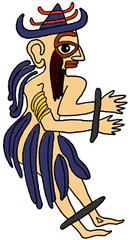
In addition to Ninkasi, the Sumerian pantheon of gods included Dumuzi, who was also a brewing god. Dumuzi may also have been related to Tammuz, a god of food and vegetation worshipped by the Hebrews, Arabs and Akkadian, along with the later Mesopotamian states of Akkad, Assyria and Babylonia. He was also sometimes referred to as Dumuzi-Amaushumgalana. He had a famous courtship with Inanna, the Sumerian goddess of sexual love, fertility, and warfare.
Holiday: Celebration of the Marriage of Inanna and Dumuzi, March 30 (Day 10 of Akitu)
Links: Godchecker / Wikipedia
- Dumuzi: Sumerian God of Brewing
-
- Ebisu: Japanese God of Fortune
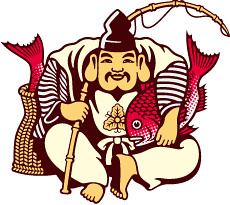
Ebisu is the Japanese god of Good Fortune, the Ocean and Fishermen. He is also one of the Seven Gods of Fortune, “and the only one of the seven to originate from Japan.” His name is also transliterated as Yebisu, which is where the beer from Sapporo gets it name.
Holiday: Ebisu Festival, October 20
Links: Godchecker / Who’s Who in Buddhism / Wikipedia
- Ebisu: Japanese God of Fortune
-
- Eight Immortal Drinkers: Chinese Epic Poem

Not to be confused with the Eight Immortals, the Eight Immortal Drinkers were a creation of the Chinese poet Du Fu, who immortalized them in his epic poem Song of Eight Immortal Drinkers. They included He Zhizhang (賀知章,會稽人,自稱秘書外監), Wang Jin (王璡,讓皇帝長子璡,封汝陽王; sometimes called 李璡 Li Jin), Li Shizhi (李適之,天寶元年爲左丞相), Cui Zhongzhi (崔宗之,日用之子,襲封齊國公), Su Jin (蘇晉,珦之子,官至左庶子), (Li Bai 李白), Zhang Xu (張旭,善草書), and Jiao Sui (焦遂,甘澤謠,布衣焦遂,爲陶峴客).Ode to Eight Immortal Drinkers by Tu Fu showed a joyful and interesting feast, and described the “eight immortal drinkers” with different characters vividly. There is an ancient saying that: “When two scholars are talking, they are surely exchanging marvelous opinions”. What spectacular event was it when “eight immortal drinkers” gathered together? We can only image such a scene through Tu Fu’s poem. “Eight immortal drinkers” included the poet He Zhizhang, Ruyang Prince Li Jin, Left Prime Minister Li Shizhi, the beauty Cui Zongzhi, the vegetarian Su Jin, Immortal Poet Li Po, the calligrapher Zhang Xu and the master-hand in debating Jiao Sui.
The “eight immortal drinkers” were all celebrities at that time. They may be officials at the same Court, make friends with each other due to poetry or literature, or just find each other congenial. Such feast may be at day or night. They may drink together to their hearts’ content at uninterrupted autumn rain or thunder of spring. Tu Fu recorded such scene by poem, which was passed down to later ages.
Holiday: Feast of Eight Immortal Drinkers, 8th Day of the 8th Lunar Month (September 12, in 2013).
Links: Confucius Institute / Du Fu
- Eight Immortal Drinkers: Chinese Epic Poem
-
- Enkidu: Mesopotamian Wild Man character in the Epic of Gilgamesh
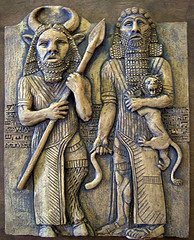
The epic poem Gilgamesh was written in ancient Mesopotamia as early as 2150 BCE and there are versions in Sumerian, Akkadian and Babylonian languages. It is considered to be one of the very earliest works of literary fiction. The main characters in the story are Gilgamesh, a king, and Enkidu, a half-wild man. The two of them go on several quests and have many dangerous and thrilling adventures. Naturally, in such an epic story, beer figures prominently. Enkidu was part wild, and as such was a savage, more beast than man. But in Tablet II of the Epic of Gilgamesh, Enkidu is confronted by a prostitute named Shamhat.They placed food in front of him, they placed beer in front of him; Enkidu knew nothing about eating bread for food, and of drinking beer he had not been taught.
The harlot spoke to Enkidu, saying: “Eat the food, Enkidu, it is the way one lives. Drink the beer, as is the custom of the land.”
Enkidu ate the food until he was sated, he drank the beer — seven jugs! — and became expansive and sang with joy! He was elated and his face glowed. He splashed his shaggy body with water, and rubbed himself with oil, and turned into a human. He put on some clothing and became like a warrior!
You read that correctly. Enkidu drank seven jugs of beer and became human. That must have been some pretty spectacular beer. In the image above, Enkidu is on the left, with his friend Gilgamesh on the right.
Holiday: Feast of Fabulous Wild Men, January 12
Links: Godchecker / Wikipedia
- Enkidu: Mesopotamian Wild Man character in the Epic of Gilgamesh
-
- Gabjauja: Lithuanian Goddess of Grain
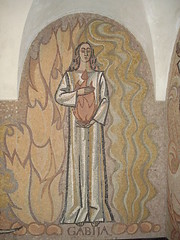
Gabjauja (Sometimes Gabija, Gabieta or Gabeta) was the Lithuanian goddess of grain, fire and the hearth. According to one source, “she was a goddess of stack-yards and grain. Women made beer and bread for Gabjauja’s feast, which only kin would attend. The head of the family would pour a scoop of beer on the ground and say a prayer. According to the Encyclopedia Mythica, “with the advent of Christianity she was, as were so many other heathen deities, reduced to a demon.”
Holiday: Kirvis Harvest Festival, Lithuania, August 23; International Festival of Fire Sculptures, Lithuania, September 22
Links: Godchecker / Wikipedia
- Gabjauja: Lithuanian Goddess of Grain
-
- Gambrinus: Flemish King of Beer
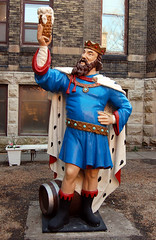
King Gambrinus was a legendary king of Flanders, which is now part of Belgium, and is considered to be the unofficial patron saint of beer and brewing. His origin, if indeed he was real, is something of a mystery. He may have been Jan Primus, also known as John I, Duke of Brabant, who lived from 1252-1294. Or he may have been John the Fearless, also known as John II, Duke of Burgundy, and he lived from 1371-1419). Jan Primus was his great-grandfather. In addition, records indicate that one of Charlemagne’s cupbearers had the name Gambrinus. The name may also derive from the Latin “ganeae birrinus,” meaning “one who drinks in a tavern.”Regardless of who the real Gambrinus was, he is believed to be the inventor of hopped malt beer. Burkart Waldis, a German poet, explained in a 1543 poem that Gambrinus had learned the art of brewing from Isis, the Egyptian goddess of motherhood and fertility.
According to legend, Gambrinus began life in poverty as the apprentice to a glassmaker in the kingdom of Flanders. But he fell in love with his master’s daughter, Flandrine, who rejected him. So he ran away to become a poet and musician, finding renown at both. But while performing one day, he saw Flandrine and began to shake, playing so poorly that his audience chased him away. He ran into the forest, bent on ending his life. But the devil appeared to Gambrinus and offered him a deal. The devil offered to make him forget Flandrine in exchange for getting his soul for thirty years.
Gambrinus accepted the bargain and his passion for Flandrine was replaced by gambling, at which he excelled. He grew rich and once more his thoughts turned to Flandrine. Thinking she might now return his love because of his wealth, she again refused him because no matter how much money he had, he still wasn’t of noble birth. Gambrinus returned to the forest, more determined than ever to take his own life, when again the devil appeared. He chastised Satan for not living up to his end of the bargain. Suddenly, in front of him, a field appeared lined with tall poles with flowing green plants hanging from them that gave off a strong, pleasant aroma. The devil told Gambrinus they were hops and beyond the field was a hophouse and a brewery. “Come on,” said the devil. “I will teach you how to make beer, and you will forget all about Flandrine.”
After learning to brew, Gambrinus asked the devil how he could have his revenge on the audience that chased him away when he playing badly. The devil suggested an instrument no one could resist, and taught him to play the chimes. Returning to the town, he planted hops and made more beer. Once it was ready, he returned to the town square and began playing this chimes and offered his new beer for people to try. They found it too bitter initially and also too strong. But after Gambrinus had played the chimes for several hours and they had danced themselves thirsty, they tried his beer again. This time, they decided it was the best dink they had ever tasted, and his success spread far and wide. Everywhere he went, Gambrinus planted hops, brewed beer and entertained people on his chimes. The king of Flanders offered to make him a duke in order to thank him, but Gambrinus preferred the nickname he had already been given by his customers: The King of Beer.
He did indeed forget all about Flandrine, and in fact did not even recognize her when she paid him a visit many years later. Gambrinus’ beery rule lasted for thirty years, when at last the devil came to collect his soul. But he began to play the chimes, and the devil could not stop dancing. Eventually the devil begged Gambrinus to stop playing and he broke their agreement. When he finally passed away, a beer barrel was found at the spot where he normally spent his days, and that’s why Gambrinus has no tombstone.
Holiday: Birthday of Gambrinus, April 11; Gambrinus Night (Ireland), August 18
Links: Beer Advocate / Froth-N-Hops / Wikipedia
- Gambrinus: Flemish King of Beer
-
- Gnomes and Trolls: Belgian Beer Spirits



While trolls are from Norse mythology and gnomes originated during the Renaissance, for some reason they’ve really been embraced by Belgian brewers. One brewer explained to me that they’re part of the Flemish peoples’ sense of playfulness. Whatever the reason, I love seeing them on their beer labels, from the beers of Achouffe , the drawings of Bas van Ostaden on all of the Urthel beers, and the Cuvee de Trolls from Dubuisson. This group should also include brownies, cluricanes, fairies, kobolds, leprechauns, and pixies too. I’m sure there are more, but that’s a good start. It’s always good to have a lucky troll or gnome around your beer.
Holiday: April Fool’s Day, April 1; Holiday of the Happy Gnomes, June 11; Thirsty Troll Brew Fest, Wisconsin, September 14, in 2013 (2nd Saturday)
Links: Fireheart / Wikipedia Gnome / Wikipedia Troll
- Gnomes and Trolls: Belgian Beer Spirits
-
- Goibhniu: Celtic Brewer of the “Beer of Immortality”
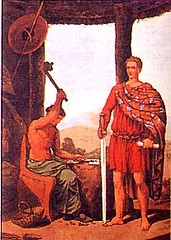
Goibhniu was the great blacksmith of Celtic mythology who supplied weaponry to the Gods. He was also the brewer of the “Beer of Immortality,” which granted anyone who drank it eternal life.
Holiday: Fledh Ghoibhnenn (Feast of Goibhniu), July 7.
Links: Godchecker / Wikipedia
- Goibhniu: Celtic Brewer of the “Beer of Immortality”
-
- The Green Man: Celtic God or Spirit of Nature

In Celtic mythology, the Green Man, who also sometimes referred to as the Horned Man, represented the masculine, active side of nature; the Earth Father. Animals sacred to him included the bear, bull, goat and the stag. He was the god of growing things, the forest, wild animals, desire, fertility, and beer and ale.
Holiday: Clun Green Man Festival, England, May 4-6 (in 2013); Pilton Green Man Festival, England, July 20 (in 2013)Green Man Festival, Wales, August 15-18 (in 2013)
Links: Encyclopedoa Mythica / Wikipedia
- The Green Man: Celtic God or Spirit of Nature
-
- Gunnlöð: Norse Giantess

Gunnlöð, or more simply Gunnlod, was a Norse goddess, and a giant, like her father Suttungr, who asked her to guard the mythical “Mead of poetry,” which he’d hidden in a cave. Odin, who wanted the mead for its magical properties — hey, who wouldn’t? — snuck in and seduced Gunnlöð. He either (tales vary) “bargained three nights of sex for three sips of the mead and then tricked her, stealing all of it” or “Gunnlöð helped Odin willingly,” as told in the Norse poem Hávamál. If you want the whole story, check out Gunnlod’s Tale.
Holiday: Gunnlöð Festival, August 24.
Links: Godchecker / Wikipedia
- Gunnlöð: Norse Giantess
-
- Habonde: Welsh Goddess of Abundance
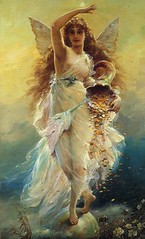
Habonde was the Welsh Goddess of abundance and prosperity, and apparently existed in many other cultures, too, and was also called Habondia, Abondia, Abunciada, Nicneven Diana, Pomona and Fortuna. She may also have been associated with the Roman Goddess Abundantia. In addition to abundance and prosperity, she was also a Goddess of the harvest, joy, health, fertility and magic. Her symbol is the Horn of plenty a cornucopia typically filled with fruit. Her rituals included sacred bonfires in which the participants danced about them for her blessing. Ale was her sacred brew and used in her harvest festivals. According to Journeying to the Goddess, “On the first Monday in July, people in Wales prepare for a lunch of ale brewed eight months ago. This is taken joyfully around town and shared to bring joy, prosperity and longevity to everyone, courtesy of the Goddess and the local brewers’ guild. If you’re a home brewer, this is an excellent day to make ritual beer or wine, both of which have to boil on the hearth, a symbol of Habonde. As you work, stir clockwise to draw positive energy your way.” To drink a toast, and “pour yourself a glass of beer, and lift it to the sky saying, ‘Habonde, bring abundance. Habonde, health and luck bring. When through my lips this liquid passes, let my soul sing!’ Drink expectantly.”
Holiday: Feast of Habondia, 1st Monday in July
Links: Journeying to the Goddess / Wikipedia
- Habonde: Welsh Goddess of Abundance
-
- Halki: Hittitie God of Grain
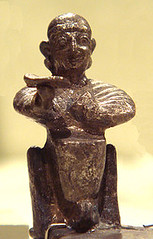
Halki was a God of Grain, especially barley, who was worshipped by early Hittitie brewers. The Hittities lived in Anatolia, in what is now northwest Syria.
Holiday: Feast of Agios Ioannis, August 29
Links: Encyclopedia Mythica / Wikipedia
- Halki: Hittitie God of Grain
-
- Hanseath: Dwarven God of Alcohol
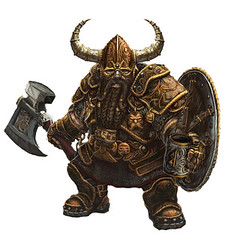
In the game Dungeons & Dragons, Hanseath is lesser god of war, carousing and alcohol. Also known as “The Bearded One,” he “represents the festive side of Dwarven culture.” According to the rulebook, “Brewers hold him in high regard.”
Holiday: Feast of Hanseath, July 27.
Links: D&D Rulebook / Wikipedia
- Hanseath: Dwarven God of Alcohol
-
- Hapi: Egyptian Goddess of Barley
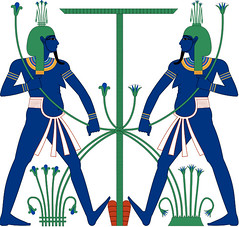
Hapi, or Hapantalli, was a goddess of the Nile, fish, barley, grain, herbs, water, dew, & fertility. “He is typically depicted as a man with a large belly wearing a loincloth, having long hair and having pendulous, female-like breasts.”
Holiday: Wafaa El-Nil (Flooding of the Nile), August 25
Links: Godchecker / Wikipedia
- Hapi: Egyptian Goddess of Barley
-
- Hathor: Egyptian God of Drunkenness
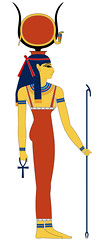
Hathor was the Egyptian Goddess of Drunkenness. The name Hathor is believed to derive from “House of Horus,” one of the oldest and most significant Egyptian deities. Here’s what she looked like: “Generally, Hathor is pictured as a woman with cow’s horns with the sun between them (Eye of Ra, Golden One), or as a beautiful woman with cow’s ears, or a cow wearing the sun disk between her horns, or even as a lioness or a lion-headed woman (destruction and drunkeness). She often is seen carrying a sistrum, an ancient musical instrument (hence a goddess of music). The sycamore was sacred to her (Lady of the Southern Sycamore). She is said to be the mother of the pharaoh, and is often depicted in a nurturing role, suckling the pharaoh when he was a child (hence a goddess of motherhood).” According to the Goddess Guide, “Hathor the Egyptian Goddess also had a darker side, as the Eye of Ra, she took on the persona of the Goddess Sekhmet. In one myth at the request of her father, she turns into Sekhmet so she can to punish humans for transgressing against him. When she nearly wipes out all of humanity, Ra tries to stop her and eventually succeeds by getting her drunk. She instantly forgets about her task and goes back to being Hathor.” See The Eye of Ra for the full story
Holiday: January 23 (Day of Hathor), April 1 (another Day of Hathor), August 29 (Nativity of Hathor); September 17 (Feast of Het-Hert); October 4 (Feast of Hathor); Hathor’s Moon Festival, October 26; December 23 (Festival of the Great Heat (Feast Day of Hathor))
Links: Godchecker / Wikipedia
- Hathor: Egyptian God of Drunkenness
-
- Hephaestus: Greek Blacksmith God & Brewer

Hephaestus is the Greek god of blacksmiths, craftsmen, artisans, among others. Hephaestus’ Roman equivalent is Vulcan. In Greek mythology, Hephaestus was the son of Zeus and Hera, the king and queen of the gods. Similar to the Celtic Goibhniu, as a blacksmith, some accounts also indicate that he was also a brewer.
Holiday: Feast of Hephaestus, April 23; Vulcanalia (a.k.a. Festival of Vulcan and the Nymphs), August 23
Links: Godchecker / Wikipedia
- Hephaestus: Greek Blacksmith God & Brewer
-
- Hoppiata: Goddess of the Hop
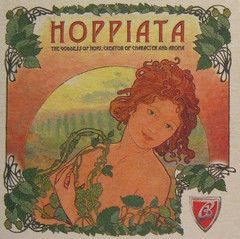
Sadly, as far as I can tell, there is no god or goddess or spirit dedicated to hops. I suspect that’s because the importance of hops to early man was quite limited, and its common use in beer didn’t occur until well after civilization had stopped creating gods to explain the world around them. But it still feels like we should have a god of hops or hop goddess, doesn’t it? The closest I could find was Hoppiata, a creation of the Czech brewery Budejovicky Budvar in 2010, for an ad campaign they did for the British market.
Holiday: Yakima Tribe Root Festival (Native American), April 30; Moxee Hop Festival, Washington, August 2-3 (1st Fri./Sat.); Poperinge Beer & Hop Festival, Belgium, September 19-21, in 2014 (every 3 years, Fri.-Sun., 3rd Weekend); Yakima Fresh Hop Ale Festival, October 5, in 2013 (1st Saturday)
Links: Real Ale Reviews / Wikipedia
- Hoppiata: Goddess of the Hop
-
- Huitaca: Chibcha (Colombian) Goddess of Drinking, Dancing and Merry-Making

To the Chibcha people of present-day Colombia, Huitaca is the Goddess of Drinking, Dancing and Merry-Making, and sometimes referred to as the “Drunken Goddess of Bad Behavior.” The head God Bochia said her partying ways made her unfit to be a Goddess and today she’s considered a bad influence. Some stories even say Bochia turned her into an owl as punishment for having a good time and enjoying herself.
Holiday: Carnaval de Barranquilla a.k.a. Barranquilla’s Carnival, March 1 (in 2014; Saturday before Ash Wednesday)
Links: Godchecker / Wikipedia
- Huitaca: Chibcha (Colombian) Goddess of Drinking, Dancing and Merry-Making
-
- Ibeorgan: Panamanian Father of Beer

A culture-hero in Panama. He is said to have taught his people, the Kuna, how to build, fashion gold, make beer from maize and many other useful things.
Holiday: Colon Day (Panama), November 5
Links: Mythology Dictionary
- Ibeorgan: Panamanian Father of Beer
-
- Icovellauna: Ouranian Goddess of Ale Brewing
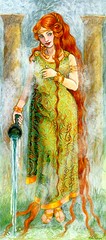
In occult and magic circles, Ouranian Barbaric is a language and world all its own, and Icovellauna is their Goddess of Ale Brewing. She’s also often thought of a goddess of healing and a spring water deity, and is referred to as the “Divine Pourer of the Waters” or the “Divine Source of the Waters.” One of her temples was found at Le Sablon, in Metz, which is in France. It was “an octagonal structure built above a watersource. A stone staircase leads around the outer walls and down to the watercourse (which is now dried up).”
Holiday: Icovellauna Water Festival, March 2.
Links: Godchecker / Wikipedia
- Icovellauna: Ouranian Goddess of Ale Brewing
-
- Inanna: Sumerian Goddess and Patroness of Tavern Keepers
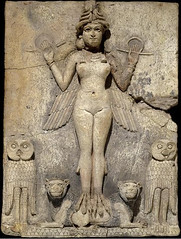
Inanna was the Sumerian goddess of sexual love, fertility, and warfare, and was also the patroness of tavern keepers.
Holiday: Birthday of Inanna, January 2; Celebration of the Marriage of Inanna and Dumuzi, March 30 (Day 10 of Akitu); Day of Inanna, August 20
Links: Godchecker / Wikipedia
- Inanna: Sumerian Goddess and Patroness of Tavern Keepers
-
- Jehovah: Hebrew Protector of the Barley
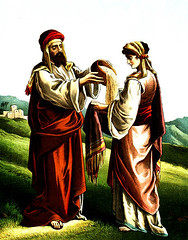
The original Hebrew God was also known as the “Protector of the Barley.” Passover is the oldest Jewish festival, originating more than three thousand years ago. Originally it was two festivals held concurrently in the spring. One was a rite involved unleavened bread and the other the sacrifice of a lamb. “Passover” referred to both of them collectively, and at some point they merged into one celebration. The first of the two, “The Feast of Unleavened Bread” is believed to have its roots as an agricultural festival celebrating the annual spring barley harvest.
Holiday: Barley Harvest Festival, March 27; Passover (begins on sunset the 15th day of Nisan in the Hebrew calendar; or in 2014, April 14)
Links: Godchecker / Wikipedia
- Jehovah: Hebrew Protector of the Barley
-
- John Barleycorn: English Personification of Barley

Long before the iconic album, John Barleycorn Must Die, by the band Traffic, the English folksong of John Barleycorn was a popular tale. Primarily an allegorical story of death, resurrection and drinking, the main character, the eponymous John Barleycorn, is the personification of barley who is attacked and made to suffer indignities and eventually death. These correspond roughly to the stages of barley growing, like reaping and malting. Some scholars see the story as pagan, representing the ideology of the cycles of nature, spirits and the pagan harvest, and possibly even human sacrifice. After John Barleycorn’s death, he is resurrected as beer, bread and whisky. Some have also compared it to the Christian transubstantiation, since his body is eaten as bread and drank as beer.There are many, many different versions of the story, which began appearing at least as early as 1568. While they differ slightly, the substance of the song has remained largely the same. The Scottish poet Robert Burns published his own take on the story in 1782.
Here, for example, is the part of the song that takes place after he’s planted in the ground until the beginning of the harvest.
They’ve plowed, they’ve sown, they’ve harrowed him in,
Threw clods upon his head.
And these three men made a solemn vow:
John Barleycorn was dead.They’ve let him lie for a very long time,
Till the rains from heav’n did fall.
And little Sir John sprung up his head,
And so amazed them all.They’ve let him stand ’till midsummer’s day,
Till he looked both pale and wan.
And little Sir John’s grown a long, long beard,
And so become a man.They’ve hired men with scythes so sharp,
To cut him off at the knee.
They’ve rolled him and tied him by the waist,
Serving him most barb’rously.It’s strange imagery. It sounds so brutal, but they’re just talking about the cereal grain barley. John Barleycorn is not a real person, or is he? To read more about John Barleycorn, and see several full versions of the song, see my John Barleycorn page.
Holiday: Midsummer’s Day, June 24; Lughnasadh Grain Harvest Festival, July 31-August 1 (begins at sunset); Lammas Grain Harvest Festival, August 1; Coquetdale John Barleycorn Festival, England, 2nd Weekend in August
Links: Cottagepedia / Evolution and Folk Song / Omniscrit / Wikipedia
- John Barleycorn: English Personification of Barley
-
- Jurupari: South American Guarani/Tupi God
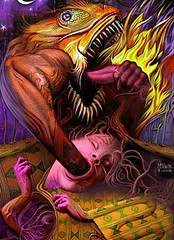
Jurupari is a “god of the Tupi Indians. Son of Creucy. He was said to have been born when the sun impregnated Creucy with the sap of a tree or as the result of a virgin birth caused by beer or a fish-bite. Until then, women had ruled the world but Jurupari gave all power to men and any woman who saw his image died of poison. He still roams the earth seeking a wife for his father, the sun.” The worship of Jurupari takes place during six celebrations throughout the year, known as the Dabucuri (Initiation Rites of the Young Men), during which all of the young men are painted red and black,, and drink alcoholic beverages brewed with local fruits. They chant and sing, and the priest of the tribe marries them off to women in the tribe, and the pairs are sent into the forest until the ceremonial paziuba horn blows, calling the women back (which sounds like an Amazonian version of post office). Afterwards, a party ensues which one source describes as a Saturnalia, but which sounds more like a wild orgy.
Holiday: Dabucuri assaby, January 1; Dabucuri ucuqui, February 2; Dabucuri mirtis, March 3; Dabucuri pataub, May 4; Dabucuri umari, July 5; Dabucuri uiga, November 6
Links: Godchecker /Mythology Dictionary / Non-Classical Mythology / Wikipedia
- Jurupari: South American Guarani/Tupi God
-
- The Kalevala: The Finnish Origins of Beer
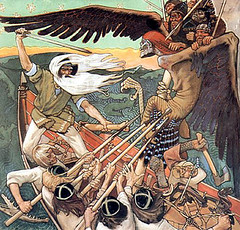
Though not published until 1835, the Kalevala is known as the “Epic Poem of Finland,” and consists of Finnish and Karelian folklore compiled by Elias Lönnrot from ancient texts of the people of what is now Finland. It consists of 22,795 verses, divided into fifty chapters” of which Chapter 20 is called “The Brewing of Beer.” Twice as many lines of the poem are devoted to the origin of beer than to mankind’s origins!“Osmotar, the beer-preparer,
Brewer of the drink refreshing,
Takes the golden grains of barley,
Taking six of barley-kernels,
Taking seven tips of hop-fruit,
Filling seven cups with water,
On the fire she sets the caldron,
Boils the barley, hops, and water,
Lets them steep, and seethe, and bubble
Brewing thus the beer delicious.”To read the entire beer brewing section, Rune XX, see my Kalevala page.
Holiday: Kalevala Day, February 28
Links: Godchecker / Wikipedia
- The Kalevala: The Finnish Origins of Beer
-
- Kamui Fuchi: Japanese Goddess of the Hearth (and Beer)

Kamui Fuchi, or Kamuy Fuchi, was an ancient Japanese goddess — specifically of the Ainu people — who protected the hearth. To worship her, the Ainu people would recite prayers and give offerings while they were cooking rice and brewing beer. You could scare away evil spirits by offering her the first sip of a freshly poured glass of beer. Yet another source gives this account:The hearth goddess of the Ainu people of Japan is Kamui-fuchi. She presides over the home, is a goddess of female fertility and is also a beer goddess. Fermentation of yeast and brewing of beer are done with prayers and offerings to her. The first brew of the fermented rice or millet is poured out on the hearth as an offering to her, to ask for her protection from negative energies and bad spirits. Mugwort is also placed as offerings and chewed during the brew fermenting process by the tribes people.
Holiday: Festival of Hettsui No Kami of the Hearth, November 8
Links: Hearth Goddesses / Wikipedia
- Kamui Fuchi: Japanese Goddess of the Hearth (and Beer)
-
- Khuzwane: An African God of Beer

Khuzwane was the god of beer and muddy footprints for the Lovedu and VhaVenda people of Transvaal. While little is known about him, he was also apparently one of their supreme deities, and may also have been known by the name Mwari.
Holiday: Africa Day, May 25
Links: Godchecker / Wikipedia
- Khuzwane: An African God of Beer
-
- Kirin: Mythical Asian Unicorn; See Qilin.
-
- Kobold: A Germanic sprite; See Biersal.
-
- Kull Gossaih: Indian Goddess of Grain

Kull Gossaih is a Goddess of Grain in India, as described in James Frazer’s Golden Bough. “Among the hill tribes near Rajamahall, in India, when the kosarane grain is being reaped in November or early in December, a festival is held as a thanksgiving before the new grain is eaten. On a day appointed by the chief a goat is sacrificed by two men to a god called Chitariah Gossaih, after which the chief himself sacrifices a fowl. Then the vassals repair to their fields, offer thanksgiving, make an oblation to Kull Gossaih, and then return to their houses to eat of the new kosarane. As soon as the inhabitants have assembled at the chief’s house, a hog, a measure of kosarane, and a pot of spirits are presented to the chief, who in return blesses his vassals, and exhorts them to industry and good behavior; ‘after which, making a libation in the names of all their gods, and of their dead, he drinks, and also throws a little of the kosarane away, repeating the same pious exclamations.’ Drinking and festivity then begin, and are kept up for several days. The same tribes have another festival at reaping the Indian corn in August or September. Every man repairs to his fields with a hog, a goat, or a fowl, which he sacrifices to Kull Gossaih.”
Holiday: Kull Gossaih Corn Festival, August/September; Chitariah Gossaih Thanksgiving; Mid-November/Early December
Links: The Golden Bough / Wikipedia
- Kull Gossaih: Indian Goddess of Grain
-
- Kurmilinos or Κυρμιληνός: Balkan Celts God of Beer
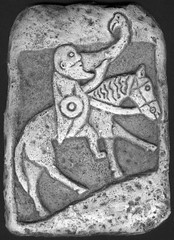
Κυρμιληνός (pronounce Kurmilinos) is the God of Beer for Celts in the Balkans Peninsula area.The Celts also ‘exported’ their beer to Thrace during the eastern expansion of the 4th/3rd c. BCE, and the fact that the liquid nectar was ‘worshipped’ among the Balkan Celts is testified to in the name of the local God (epithet of Apollo) – Κυρμιληνός – in an inscription from Ezerovo, Bulgaria, the Celtic epithet of the Greek God being yet another example of the synthesis of cultures in Thrace during this period. Besides Κυρμιληνός, the element also occurs in many Celtic personal names such as Curmillus, Curmissus etc., indicating that these individuals were probably brewers by profession. The last word on this subject undoubtedly belongs to a Pannonian Celt called Curmi-Sagius, whose name literally means ‘The Beer Seeker’ / ‘He Who Searched For Beer’ – apparently a particularly devoted disciple of the Great Beer God.
Not much else is known about Κυρμιληνός, and I couldn’t find any additional references.
Holiday: Zadoushnitza (Bulgarian All-Souls’ Day), February 14; Makaveyan Days (for 3 days, or more, villages are trimiryat, which is a celebration where hunger and thirst are purified), August 1-3
Links: Balkan Celts / Wikipedia
- Kurmilinos or Κυρμιληνός: Balkan Celts God of Beer
-
- Lan-Caihe: Chinese Drunken Eight-Immortal

Lan-Caihe was one of the Eight-Immortals of Chinese Mythology. Originally a herb salesman, beggar and a busker (or street musician), he helped a disguised beggar and was rewarded with immortality. He usually portrayed as effeminate (and sometimes as a transvestite) and almost always drunk. He also wears only one boot and a wooden belt and prefers sleeping semi-nude in the snow. Each of the Eight immortals represented an aspect of Taoism and though not being quite gods and allowed into heaven, they were set up on a mountainous island in the east known as Penglai-Shan. They had many adventures together (sort of the original crime-fighting team or Justice League) and were the subject of many Taoist legends and stories.
Holiday: Birthday of Lan-Caihe, 25th Day of the Sixth Lunar Month (August 1, in 2013)
Links: Godchecker / Wikipedia
- Lan-Caihe: Chinese Drunken Eight-Immortal
-
- Macuiltochtli: Aztec God of Alcoholic Beverages; a.k.a. “Five Rabbit”
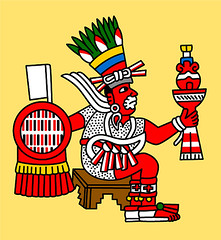
Macuiltochtli is one of the Four Hundred Drunken Rabbit Gods, known as the Centzon-Totochtin. His name is translated as “Five Rabbit.” Randy Mosher’s beer company, Five Rabbit Cerverceria, is named for Macuiltochtli
Holiday: Centzon-Totochtin Drunken Rabbit Day, Last Saturday in September (28th in 2013); Rabbit Rabbit Day, Last Day of Each Month
Links: Godchecker / Wikipedia
- Macuiltochtli: Aztec God of Alcoholic Beverages; a.k.a. “Five Rabbit”
-
- Maeve: Irish Queen of Connacht; See Medb.
-
- Mami: Sumerian Goddess of Drunkenness
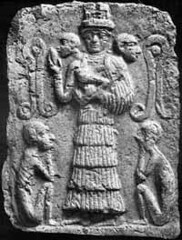
Mami was a goddess of drunkenness & midwives. She was also known as Mama or Mamitu.
Holiday: Sumerian New Year, October 7
Links: Godchecker / Wikipedia
- Mami: Sumerian Goddess of Drunkenness
-
- Mamlambo: Zulu Goddess of Beer-makers
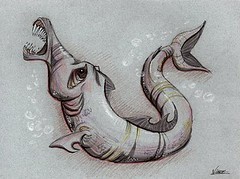
A Zulu river-goddess, goddess of beer-makers. In many instances, she’s depicted as a giant reptile monster, and occasionally as having “the torso of a horse, the lower body of a fish, short legs, and the neck of a snake, and that it shined with a green light at night.”
Holiday: Umhlanga Day (Swaziland), August 23; Umhlanga (Zulu Reed Dance Ceremony), 8-Day Festival in late August/early September
Links: Unexplained / Wikipedia
- Mamlambo: Zulu Goddess of Beer-makers
-
- Marduk: Babylonian Beer-Brewing God
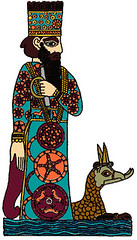
Marduk was originally a Sun God who eventually became the primary or chief diety in later Babylonian times. He was also associated with brewing and was a Beer-Brewing God who had many symbols and fifty names. One of Marduk’s many symbols is also the one I adapted for my own logo.
Holiday: Feast of Marduk (Mesopotamian), March 12; Marduk’s Festival, March 15; Akitu, a.k.a. Zagmuk (Mesopotamian spring festival, “cutting of the barley,” celebrating Marduk’s victory over Tiamat), March 21
Links: Godchecker / Wikipedia
- Marduk: Babylonian Beer-Brewing God
-
- Mati-Syra-Zemlya: Slavic Goddess of the Earth

Mati-Syra-Zemlya is a middle European goddess of the Earth, and was worshipped in Russia, Poland and the Czech Republic, at least. According to another source she was the “Slavic Goddess of the Earth,” and one of her nicknames was “Moist Mother Earth.” She’s from prehistory so little is know about her origin, though she’s “a vague personification of the earth (literally, “Damp Mother Earth”)” and “is believed to be the most ancient and powerful of all of the Eastern European deities.” As a goddess of soil and oil, if she takes human form, she’s usually dark-skinned, the color of dirt of even black. According to the Encyclopedia of Russian and Slavic Myth and Legend, each spring bread would be buried in the ground for her to eat, and beer was poured in holes for her to drink. In fact, it was said that she would often appear as a hole in the ground, so if you see one, here’s what’s recommended to honor Mati-Syra-Zemlya.Speak into it. If you are going on a journey, kiss it. She is very partial to bread, wine and beer. Drop and pour it down. Don’t be stingy. And if you plow a furrow round your house at night you will be plague-free.
Other names she’s been known by include Matka, Mata Syra Zjemlja, Matushka Zemlia, Mokos and Mokosh.
Holiday: Mati-Syra-Zemlya Pregnancy Day (no plowing), May 1; Zemlya’s Night (when she would “take human form and appear as a dark skinned Slavic woman dressed in brightly colored ribbons and ornaments, she would then visit homes bestowing blessings), June 24; Mati-Syra-Zemlya Day, August 1.
Links: Godchecker / Wikipedia
- Mati-Syra-Zemlya: Slavic Goddess of the Earth
-
- Mayahuel: Goddess of Alcohol, Mother of the 400 Drunken Rabbit Gods; see Centzon-Totochtin

Mayahuel is the goddess of the maguey plant and of fertility. She’s also the protector of mature wombs that turn into life, and she has many breasts to feed her hundreds of children, the Centzon Totochin (the 400 Drunken Rabbits). Patecatl is her husband.
Holiday: Centzon-Totochtin Drunken Rabbit Day, Last Saturday in September (28th in 2013); Rabbit Rabbit Day, Last Day of Each Month
Links: Godchecker / Wikipedia
- Mayahuel: Goddess of Alcohol, Mother of the 400 Drunken Rabbit Gods; see Centzon-Totochtin
-
- Mbaba-Mwanna-Waresa: Zulu Goddess of Beer
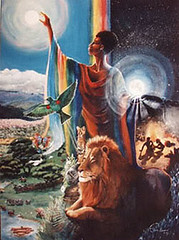
Mbaba-Mwanna-Waresa is the Zulu Goddess of fertility, the rainbow, agriculture, rain and beer; and the Zulus believed she made the first beer for her people. She’s also been known to create rainbows to signal it’s time to start drinking.
Holiday: Goddess of Fertility Day, March 18; Find A Rainbow Day, April 3
Links: Godchecker / Wikipedia
- Mbaba-Mwanna-Waresa: Zulu Goddess of Beer
-
- Medb: Irish Goddess of Intoxication
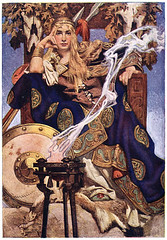
Medb was the Irish Queen of Connacht, as well as the Goddess of Intoxication. According to Journeying of the Goddess, “Her body was the Earth; Her body processes were the Earth as it created. She was the force of the rushing waters, the windswept mountains, and the fertile plains. And, like many other deities, Medb is also associated with death as well as fertility and inebriation.” It’s also spelled Meḋḃ, Meaḋḃ; Meadhbh, Méabh, Medbh or Maebh; and is sometimes Anglicized as Maeve, Maev or Maive. According to Wikipedia, “in Irish Gaelic, the name “Medbh” or “Méadhbh” means “she who intoxicates.” It is rooted in the Irish legend of Queen Maeve or Medb, one of the main protagonists of the early Irish legend Táin Bó Cúailnge. It is also associated with the fairy queen Queen Mab of Irish and English legend.” Another account claims her name means “‘intoxication’ or ‘drunken woman,’ who ran faster than horses, slept with innumerable kings whom She then discarded, and wore live birds and animals across Her shoulders and arms.”
Holiday: Beltane, April 30-May 1
Links: Godchecker / Wikipedia
- Medb: Irish Goddess of Intoxication
-
- Michael Jackson: God of Beer Writers

Okay, so this one, of course, is slightly tongue in cheek. Since his passing in 2007, our friend and colleague Michael Jackson continues to inspire and influence beer writers, beer drinkers and brewers. I considered the possibility that Michael should be canonized, but those of us who knew him understand that he was no saint. And I mean that in the best possible sense. So deifying him made much more sense. He did write the bible for both beer and whiskey lovers.
Holiday: Birthday of Michael Jackson, March 27
Links: The Beer Hunter / Wikipedia
- Michael Jackson: God of Beer Writers
-
- Min: Egyptian God of Fertility
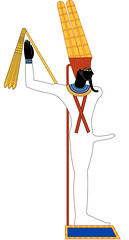
Min was the Egyptian god of fertility and sex, and as such his celebrations also had to do with the harvest, with the Egyptian would “sow their seeds” to honor him. “At the beginning of the harvest season, his image was taken out of the temple and brought to the fields in the festival of the departure of Min, when they blessed the harvest, and played games naked in his honor.” As the “central deity of fertility and possibly orgiastic rites,” I think it’s safe to assume there was much drinking, as well. Min also was “identified by the Greeks with the god Pan.”
Holiday: Feast of Min Harvest & Fertility Festival, July 11
Links: Godchecker / Wikipedia
- Min: Egyptian God of Fertility
-
- Min Kyawzwa: Burmese God of Drinking

One of 37 Nats, or spirits, worshipped in Burma, Min Kyawzwa is essentially the Burmese God of Drinking. He was probably #19, and a drunkard, cock fighter, and excellent horseman. Burmese Nats predated Buddhism, but were later incorporated into it.
Holiday: Thingyan Festival (Burmese New Year), April 13-16
Links: Myanmar Nats / Wikipedia
- Min Kyawzwa: Burmese God of Drinking
-
- Minne: German Goddess of Love and Fertility
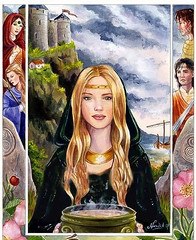
Minne is a German Goddess of love and fertility, whose symbols included the linden tree, cups and beer. Her name (meaning “remembrance”) was applied to a special cup for lovers during Lindenfest. The cup was filled with specially prepared beer and raised between two people wishing to deepen their love, often around a linden tree. According to Journeying to the Goddess, “When making a promise to each other, a couple may drink a wooden goblet of beer today, linking their destinies. Raise the glass to the sky first saying, ‘Minne’s love upon our lips, devotion in each sip.'” She may also have been associated with the Norse goddess Lofn.
Holiday: Lindenfest, 2nd weekend in July
Links: Journeying to the Goddess / Wikipedia
- Minne: German Goddess of Love and Fertility
-
- Neper: Egyptian God of Grain
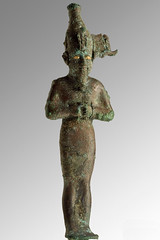
Neper was the God of Grain, primarily barley and wheat, and was thought of as the personification of grain. He was also known as Nepra or Nepri. There was also Nepit, who was also a goddess of grain, and the female counterpart of Neper.
Holiday: Festival of Renenutet, and the Birthday of Neper, April 1
Links: Godchecker / Wikipedia
- Neper: Egyptian God of Grain
-
- Nephthys: Egyptian Goddess of Beer
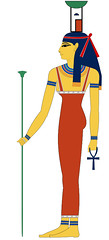
Nephthys was primarily a funerary goddess, and is usually seen with her more famous sister Isis. But “Nephthys was also considered a festive deity whose rites could mandate the liberal consumption of beer. In various reliefs at Edfu, Dendera, and Behbeit, Nephthys is depicted receiving lavish beer-offerings from the Pharaoh, which she would ‘return,’ using her power as a beer-goddess ‘that [the pharaoh] may have joy with no hangover.'”
Holiday: Nebet-Het (Birthday of Nephthys), July 18; Nativity of Nephthys, August 28
Links: Godchecker / Wikipedia
- Nephthys: Egyptian Goddess of Beer
-
- Nin-Anna: Babylonian Goddess of Beer

Nin-Anna was a Babylonian Goddess of Beer. Her names means “Queen of Heaven” (from Sumerian NIN “lady”, AN “sky”)” and was a “title used for goddesses central to many religions of antiquity.” Inanna’s name is derived from Nin-anna.
Holiday: Back to Babylon Procession & Banquet, March 29 (10 Nisan, 10th Day of Akitu)
Links: Godchecker / Wikipedia
- Nin-Anna: Babylonian Goddess of Beer
-
- Ninkasi: Sumerian Goddess of Brewing
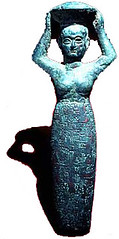
Perhaps the earliest goddess associated with beer was Ninkasi, from the Sumerian civilization. Sumer was located in southern Mesopotamia, and was one of the earliest civilizations we know about. Though there are a few older, Sumer was most likely the first to start farming, as early as 5300 BCE, and probably even sooner than that, but because writing wasn’t invented until the start of the Bronze Age—during the latter half of the 4th millennium BCE—that is the earliest definitive record we have. According to Sumerian mythology, Ninkasi was the daughter of Enki, the chief Sumerian god (Enki means “Lord of the Earth”). She was born from “sparkling fresh water” and created to “satisfy the desire” and “sate the heart.” Though references can be found to Ninkasi as long ago as 2800 BCE, the first nearly complete text is a tablet dated to around 1800 BCE and known as “The Hymn to Ninkasi.” The Hymn essentially contains the first written recipe for Sumerian beer (which they called “sikaru”) and sings he praises of the beer goddess Ninkasi. The finished beer is described in the Hymn’s last lines. “Ninkasi, you are the one who pours out the filtered beer of the collector vat, It is [like] the onrush of Tigris and Euphrates.” The image above is the one most often associated with Ninkasi, but no description or image of Ninkasi has ever been found. Who the woman depicted in the statute really is, I have no idea, nor apparently does anyone else. Jamie Floyd named his Eugene, Oregon brewery Ninkasi Brewery.Holiday: Festival of the Goddess Ninkasi, September 23
Links: Godchecker / MatriFocus / Wikipedia
- Ninkasi: Sumerian Goddess of Brewing
-
- Ninlil: Sumerian Goddess of the Grain

Ninlil was the Sumerian Goddess of the Grain. Her original name was “Sud,” but was renamed after she married Enlil, one of the major Sumerian Gods. When I say marry, that seems a bit of a stretch since Enlil raped her, at least twice, so that she gave birth to the god of water and then the god of death and sadness. In some versions, her mother, Nunbarsegunu, encouraged her with Enlil, while in others she warned her against him. Here’s one account:Her first meeting with Enlil was not as expected, he had raped her because he found her beauty unimaginable and she had conceived water, which had flown down all the rivers and gave new life. She also had a shown that flown down the water stream, he was known as Seun, the soon to be god of the moon and light.
She also gave birth to the god of death and sadness as well as the god of rivers itself. All of these were after she and Enlil have gotten married and ruled the thrones of the highest god chambers themselves. She is also known for winter storms, as many ancient Sumerians thought it was her will when the storms would rock by passed them. Enlil grew to be fond of his wife and basked her onto a meadow of bright flowers and let her roam the woods creating many more trees in the process.
In Assyria, she was known as Mullissu, or Mulliltu, and later in life (Some say after death) was considered the “Lady of the Air” or air goddess.
Holiday: Mesopotamian/Sumerian Grain Festival, March 20; Sumerian New Year, October 7
Links: Godchecker / Wikipedia
- Ninlil: Sumerian Goddess of the Grain
-
- Nunbarsegunu: Sumerian Goddess of Barley

Nunbarsegunu was a mother goddess, although not much is known about her. She’s also a “goddess of barley in Mesopotamian (Sumerian, Babylonian, and Akkadian) mythology,” and “mentioned in creation texts as the ‘old woman of Nippur,'” and identified as the mother of Ninlil.
Holiday: Mesopotamian/Sumerian Grain Festival, March 20; Sumerian New Year, October 7
Links: Wikipedia
- Nunbarsegunu: Sumerian Goddess of Barley
-
- Ometotchtli: Aztec King of the Centzon-Totochtin; a.k.a. “Two Rabbit”
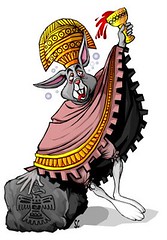
Ometotchtli is the King of the Four Hundred Drunken Rabbit Gods, known as the Centzon-Totochtin. His name is translated as “Two Rabbit.”
Holiday: Centzon-Totochtin Drunken Rabbit Day, Last Saturday in September (28th in 2013), Rabbit Rabbit Day, Last Day of Each Month
Links: Godchecker / Wikipedia
- Ometotchtli: Aztec King of the Centzon-Totochtin; a.k.a. “Two Rabbit”
-
- Onatha: Iroquois Spirit of Wheat
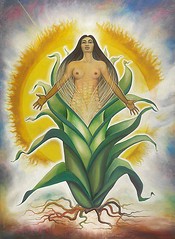
Onatha, sometimes spelled Onatah, is the Iroquois spirit of wheat, and the goddess of the harvest and maize. As a result, she’s also known as the “Corn Goddess,” too. According to An Inner Journey: “Her mother is the Earth Goddess, Eithinoha. Onatha’s tale is remarkably similar to that of the Greek Goddess, Persephone. For example, both are agricultural deities as well as the daughters of a primary Mother Goddess. In addition, both were abducted by the Underworld god.”The Iroquois legend tells us that one day when Onatha was out gathering dew, She was abducted by evil spirits who carried Her off into the Underworld. Eithinoha pleaded with the sun for help in finding Her missing daughter, and, for weeks on end, the sun radiated warmth upon the land, producing a heat wave to rescue Her; hence, the drying out the soil allowed Onatha to rise from the earth like corn. Unfortunately, the demons come back for her every year when the sun turns his back, and he must search for her again every spring.
Goddess A Day says that she “rose from the earth like wheat,” instead of corn. Yet another account, the Encyclopedia of Goddesses and Heroines offers that “men, attracted by Oniata’s loveliness, fought over Her. When the Iroquois women complained, Oniata explained that She never wished for men’s attentions. To ensure that the men would return to their families, She left the earth, leaving behind only spring wildflowers.”
Holiday: Green Corn Festival (Santa Ana Pueblo, Albuquerque, NM), July 26; Ganondagan’s Spirit Dancers/Iroquois Social Dancing Festival (Victor, NY), July 27-28, in 2013 (Last Weekend); Iroquois Indian Festival (Albany, NY), August 31-September 1, in 2013 (begins on last Saturday)
Links: Godchecker / Wikipedia
- Onatha: Iroquois Spirit of Wheat
-
- Osiris: Egyptian God of Agriculture

Osiris was the God of Agriculture. He was also one of their Gods of Beer, and is said to have taught the people how to brew beer.
Holiday: Festival of Jubilation for Osiris, January 20; Birthday of Osiris, July 14; Feast of Osiris, September 2
Links: Godchecker / Wikipedia
- Osiris: Egyptian God of Agriculture
-
- Patecatl: Aztec Lord of the Root of Pulque
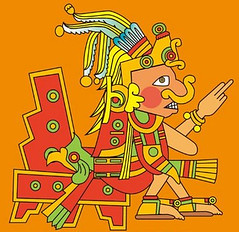
Patecatl was the Aztec god of healing and fertility, and the discoverer of peyote as well as the “lord of the root of pulque.” Patecatl is the husband of Mayahuel, and the father of the Four Hundred Drunken Rabbit Gods, known as the Centzon-Totochtin.
Holiday: Centzon-Totochtin Drunken Rabbit Day, Last Saturday in September (28th in 2013); Rabbit Rabbit Day, Last Day of Each Month; Patecatl Day, 12th day of the Tonalpohuall, Day Malinalli (Grass); Patecatl also ruled the Trecena covering the days from 1 Monkey to 13 House.
Links: Godchecker / Wikipedia
- Patecatl: Aztec Lord of the Root of Pulque
-
- Patobkia: Tupari Spirit of the Underworld

A Tupari spirit of the underworld. This shaman greets all souls arriving in the land of the dead, restores their sight and refreshes them with a drink of beer. He then presents them to the giants, Mpokalero and Vaugh’eh, with one or other of whom they are required to have intercourse.
Holiday: Dia de Finados (Day of the Dead; Brazil), November 2
Links: Mythology Dictionary / Tupari Mythology
- Patobkia: Tupari Spirit of the Underworld
-
- Pekko: Estonian & Finnish God of Fields and Crops

Pekko is the God of Fields and Crops, especially those that are used to make beer. It’s sometimes spelled Peko, Pekka or Pellon Pekko.
Holiday: Vappu (May Day), April 30; Haku Päällä Rakkausfestivaali, Kutemajarvi Sex Festival & Matchmaking Festival, June 7-8, in 2013 (begins last Friday); Eukonkanto, Finnish Wife Carrying Contest, July 4-5, in 2014 (begins 1st Friday), note: the winner receives the wife’s weight in beer.
Links: Godchecker / Wikipedia
- Pekko: Estonian & Finnish God of Fields and Crops
-
- Pereplut: Slavic Goddess of Drinking
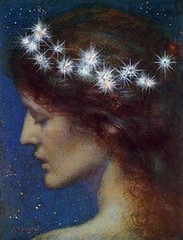
Pereplut was the Slavic goddess of drinking, changing fortunes, and also rain. She was honored by drinking from a horn, typically a ram’s horn.
Holiday: Rusalii, June 8, in 2014 (Whitsunday; 7th Sunday after Easter, during Pentecost)
Links: Encyclopedia Mythica / Wikipedia
- Pereplut: Slavic Goddess of Drinking
-
- Perkūnas: European God of Thunder
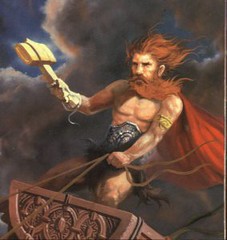
Perkūnas is the god of thunder throughout Eastern Europe, where the name is similar from culture to culture: Perkūnas (Lithuanian), Perkons (Latvian), Perkūnas (Latvian), Pērkons/Perkonis (Prussian), Perunu (Old Russian), Pyerun (Russian), Piorun (Polish), Perun (Czech), Perkūns (Finnish), and Perkele, Parkuns and Yotvingian. He was the common Baltic god of thunder, one of the most important deities in the Baltic pantheon. Perkūnas is primarily a fertility god, though in times of drought animals are sacrificed to him in the hopes of changing the weather. “When the animals are killed, then, according their custom, the people come together from all the vicinity, to eat and drink there together. They pay homage to Perkons by first pouring him beer, which is then brought around the fire, and at last pour it in this fire, asking Perkons to give them rain.”
Holiday: Jorė, April 23; Day of Perkūnas, September 22 (Autumnal equinox)
Links: Encyclopedia Mythica / Godchecker / Wikipedia
- Perkūnas: European God of Thunder
-
- Persephone: Greek Goddess of Vegetation
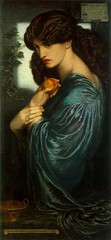
Persephone was the daughter of Zeus and the harvest-goddess Demeter, and queen of the underworld. Her nickname was Kore, though she apparently preferred Persephone. In Roman mythology, she was known as Proserpina, and her mother was Ceres. “Persephone was abducted by Hades, the god-king of the underworld. The myth of her abduction represents her function as the personification of vegetation which shoots forth in spring and withdraws into the earth after harvest; hence she is also associated with spring and with the seeds of the fruits of the fields.” As such, she’s also considered a vegetation goddess and the goddess of spring growth, and is often depicted carrying a sheaf of grain.
Holiday: Festival of Kore, January 5; Festival of Kore and Demeter (Persephone Greek Vegetation Goddess and Barley Mother Goddess), March 21; Thesmophoria (honoring the goddesses Demeter and her daughter Persephone), October 25-27 (originally 11-13 Pyanepsion); Persephone’s Day, November 25
Links: Godchecker / Mythic Arts / Theoi Greek Mythology / Wikipedia
- Persephone: Greek Goddess of Vegetation
-
- Qilin or Kirin: Mythical Asian Unicorn

A Qilin is essentially a Chinese unicorn, “a mythical hooved chimerical creature known throughout various East Asian cultures, and is said to appear with the imminent arrival or passing of a wise sage or an illustrious ruler. It is often depicted with what looks like fire all over its body.” In Japan it’s known as a Kirin, which is also their name for giraffe. “Japanese art tends to depict the Qilin as more deer-like than in Chinese art. Alternatively, it is depicted as a dragon shaped like a deer, but with an ox’s tail instead of a lion’s tail. The Kirin Brewery is named after the animal, and uses a picture of one in its labels. They are also often portrayed as partially unicorn-like in appearance, but with a backwards curving horn.”
Holiday: Bon Odori (Festival of the Lanterns; Japan), July 12, in 2014 (2nd Saturday); Culture Day (a.k.a. Bunka no hi; Japan), November 3
Links: Mythical Creatures / Obakemono Project / Wikipedia
- Qilin or Kirin: Mythical Asian Unicorn
-
- Radegast: Slavic God of Hospitality
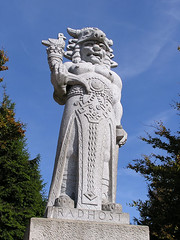
As the God of Hospitality in Slavic mythology, Radegast was also believed to have first created beer. His name can also be spelled Radigost, Redigast, Riedegost, Radogost or Radhost.
Holiday: Unknown
Links: Godchecker / Wikipedia
- Radegast: Slavic God of Hospitality
-
- Rāgarāja: Chinese God of Tavern Keepers; See Aizen Myō’ō.
-
- Ragutiene: Slavic/Baltic Goddess of Beer
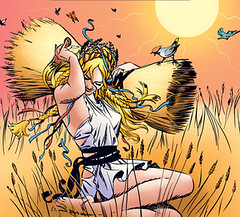
Ragutiene is partners with Raugupatis. Ragutiene is the Goddess of beer while Raugupatis is the God of Fermentation. In Lithuanian mythology there was even a third God, Ragutis, the God of Beer. Ragutiene’s consort was Ragutis, god of beer. Who knows which one felt like the third wheel. The three of them together were revered by the pagan Lithuanians, Latvians and even Prussians for the life sustaining gifts of food preservation and intoxication, and celebrated with annual feasts on the Autumnal Equinox.”
Holiday: Festival of Ragutiene and Ragutis, Autumnal Equinox (September 22 in 2013)
Links: Godchecker / Wikipedia
- Ragutiene: Slavic/Baltic Goddess of Beer
-
- Ragutis: Slavic/Baltic God of Beer
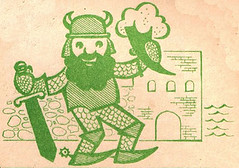
While Ragutiene and Ragutiene are the most prominent beer gods in Lithuanian mythology, there was even a third God, rounding out the brewing trinity. Ragutis was also a god of brewing and was married to Ragutiene, the goddess of beer. The three of them together were revered by the pagan Lithuanians, Latvians and even Prussians for the life sustaining gifts of food preservation and intoxication, and celebrated with annual feasts on the Autumnal Equinox.”
Holiday: Festival of Ragutiene and Ragutis, Autumnal Equinox (September 22 in 2013)
Links: Godchecker / Wikipedia
- Ragutis: Slavic/Baltic God of Beer
-
- Raugupatis: Slavic/Baltic God of Fermentation
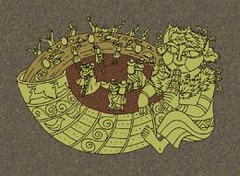
Unlike Ragutiene and Ragutis, who are considered gods, Raugupatis is “a nature spirit or demi-god that breathed life into grain, turning it into sourdough bread and beer. But they considered Raugupatis to be the God of Fermentation, in a sense — although they didn’t say so — he was in effect a god of yeast. He’s also known by the name Raugo-Zemepatis. He is often depicted kneading bread or carrying a drinking horn. His consort was Ragutiene the goddess of beer, mead and other alcoholic beverages. The three of them together were revered by the pagan Lithuanians, Latvians and even Prussians for the life sustaining gifts of food preservation and intoxication, and celebrated with annual feasts on the Autumnal Equinox.”
Holiday: Festival of Ragutiene and Ragutis, Autumnal Equinox (September 22 in 2013)
Links: Godchecker / Wikipedia
- Raugupatis: Slavic/Baltic God of Fermentation
-
- Rekereke: Polynesian God of Pleasure

On the island of Mangareva in French Polynesia, Rekereke is worshipped as the Polynesian God of Pleasure. As far as I know, there are no images of Rekereke, the above being representative of Polynesian mythology.
Holiday: Feast of Rekereke, December 12
Links: Dictionary of Polynesian Mythology / Wikipedia
- Rekereke: Polynesian God of Pleasure
-
- Sabzios: Greek God of Beer; See Dionysus.
-
- Sekhmet: Egyptian Warrior Goddess who’s celebrated during a Festival of Intoxication
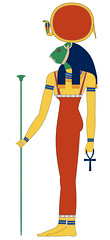
Sekhmet was an Egyptian warrior goddess with the face of a lioness. She was a fierce protector of the pharaohs and her breath was believed to have created the desert. In her most famous tale, after one particular battle, the Egyptians did not make a sacrifice to her as was usually done to stop her warrior’s bloodlust, and she nearly destroyed all of mankind. But the Egyptian sun god, Ra, tricked her by turning the water of the Nile River red so she would drink it instead. The red Nile, however, was not blood, but Pomegranate beer, which made Sekhmet so drunk that she gave up her killing ways and became a gentler goddess. The Festival of Intoxication, held at the beginning of each year commemorated this myth (when the Nile would turn blood red due to silt coming down from upstream during the annual flooding known as the inundation). The Egyptians would dance, play music and, above all, drink large quantities of red beer to ritualize the extreme drunkenness that saved mankind.
Holiday: End of the World by Sekhmet, March 12; Festival of Intoxication (Day of Sekhmet’s repulsion of Set), August 12; Day of Sekhmet and the Purifying Flame, November 20; Day of Offerings to Sekhmet, November 24; Sekhmet Days, November 28-29; Lucky Day of Sekhmet, December 31
Links: Godchecker / Wikipedia
- Sekhmet: Egyptian Warrior Goddess who’s celebrated during a Festival of Intoxication
-
- Semargl: Slavic God of Barley
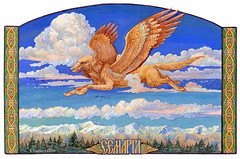
Semargl was a deity or mythical creature in East Slavic mythology, and was believed to be a griffin with a dog’s body, although some historians think it may have been a seven-headed beast. Originally two separate Gods, Sem and Argl were each Gods of Barley who eventually became one God. Maybe one was a dog and one was a griffin? Semargl was also considered a family god.
Holiday: Badnja Vece (ceremony where oak branches are blessed with barley), December 24
Links: Godchecker / Wikipedia
- Semargl: Slavic God of Barley
-
- Seonaidh: Scottish God of Ale
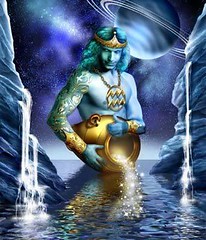
The Seonaidh, or Shoney, “are now thought to be sea faeries living off the coast of Scotland and Northern Ireland, they were once personified as a single God of the North Sea. Documentation exists showing that local fishermen continued to offer libations of ale to him as late as the nineteenth century.” They are found in not only Scotland, but also in Irish and Manx culture. According to “Dwelly’s Gaelic Dictionary:”[The people of Lewis (Leòdhas) and Harris in the Outer Hebrides honored] Seonaidh by a cup of ale in the following manner. They came to the church of St. Mulway (Mael rubha), each man carrying his own provisions. Every family gave a pock (bag) of malt, and the whole was brewed into ale. One of their number was chosen to wade into the sea up to his waist, carrying in his hand the cup full of ale. When he reached a proper depth, he stood and cried aloud:
“Seonaidh, I give thee this cup of ale, hoping that thou wilt be so good as to send us plenty of seaware [flotsam and jetsam] for enriching our ground during the coming year.”He then threw the ale into the sea. This ceremony was performed in the night-time. On his coming to land, they all repaired to church, where there was a candle burning on the altar. There they stood still for a time, when, on a signal given, the candle was put out, and straight-away, they adjourned to the fields where the night was spent mirthfully over the ale. Next morning, they returned to their respective homes, in the belief that they had insured a plentiful crop for the next season.
Similarly, the Encyclopedia of Celtic Mythology and Folklore suggests that on “Samhain the fisher folk of the island would carry out a mug of ale and pour it into the ocean, calling out to Shoney to accept the mug in return for filling the boats with fish.”
Holiday: Samhain, October 31-November 1
Links: Encyclopedia of Celtic Mythology and Folklore / Wikipedia
- Seonaidh: Scottish God of Ale
-
- Shadipinyi: Namibian God of Beer

Shadipinyi was credited with inventing beer by the Kavango peoples of Namibia. He’s also known as the “Evil God of Drunken Behavior.”
Holiday: Kuste Karneval (Coast Carnival or KüsKa), August 25-31, in 2013 (Last Week of August)
Links: Godchecker / Wikipedia
- Shadipinyi: Namibian God of Beer
-
- Shōjō: (猩々 or 猩猩 heavy drinker or orangutan) Japanese Sea Spirit
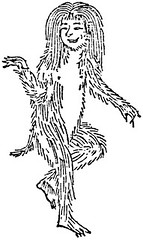
A Shōjō is a kind of Japanese sea spirit with red face and hair and a fondness for alcohol. There is a Noh mask for this character, as well as a type of Kabuki stage makeup, that bear the name. The Chinese characters are also a Japanese (and Chinese) word for orangutan, and can also be used in Japanese to refer to someone who is particularly fond of alcohol. In some mythologies the Shōjō can only be seen when the person is drunk. A Shōjō is also featured in an episode of the television Supernatural that takes place in a brewery. They also appear in In Hayao Miyazaki’s animated film Princess Mononoke as talking, ape-like creatures struggling to protect the forest from human destruction by planting trees.
Holiday: Tsushima Tennoo Matsuri (津島天王祭り) Shōjō Festival, 4th Sunday in July (begins Saturday night before); Shojo Festival at Narumi Hachimangu, Nagoya, Japan, 2nd Sunday in October
Links: Omamori: Japanese Amulets / Wikipedia
- Shōjō: (猩々 or 猩猩 heavy drinker or orangutan) Japanese Sea Spirit
-
- Shoney: Anglicized version of Seonaidh, Scottish God of Ale; See Seonaidh.
-
- Siduri: Sumerian Goddess of Brewing
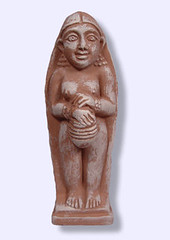
An all-purpose minor Goddess of merriment, happiness, wisdom and brewing. In the Epic of Gilgamesh, Siduri “was called the ‘hostess,’ or ‘ale-wife.'”
Holiday: Sumerian New Year, October 7
Links: Mythology Dictionary / Wikipedia
- Siduri: Sumerian Goddess of Brewing
-
- Silenus: Greek God of Beer Buddies and Drinking Companions
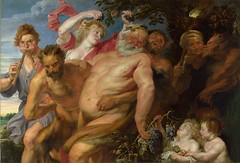
Silenus was the Greek God of Beer Buddies and Drinking Companions, who taught Dionysus (the God of Sex, Wine and Intoxication) everything he knew. “When intoxicated, Silenus was said to possess special knowledge and the power of prophecy.” According to Froth-N-Hops. “In Ancient Greek mythology, Silenus is the God of beer and a drinking companion. He is usually associated with his buddy, Dionysus. He is often featured as a bald and fat man, with a big beer belly. He is normally drunk and it is said that he had to be carried either by donkeys or satyrs (in Greek mythology, satyrs are wood-dwelling creatures with the head and body of a man and the ears, horns, and legs of a goat). He was also the god of drunkenness who rode in the train of Dionysos seated on the back of a donkey. He was depicted as a jovial old man, hairy and balding with a pot-belly and snub-nose, and the ears and tail of an ass. The old satyr was the foster-father of the god Dionysos.”
Holiday: Anthesteria, January 12; Lenaia (Festival of Drama), February 1; Feast of Bacchus, March 15; Dionysia, March 21; Oschophoria (Autumn Dionysus Festival), October 1; Satyr’s Day, 1st Saturday of each month
Links: Godchecker / Wikipedia
- Silenus: Greek God of Beer Buddies and Drinking Companions
-
- Siris: Mesopotamian Goddess of Beer
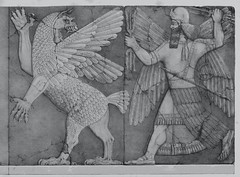
Siris was a Mesopotamian goddess and the patron of beer, or even the spirit of beer. Occasionally it was spelled Sirash. She was conceived of as a demon, though is not necessarily evil, and she’s also the mother of Zu. Siris and Zu are large birds that can breathe fire and water, at least in their earliest incarnation. The “goddess Siris was an ancient deity that preceded the Sumero-Akkadian pantheon and was depicted as a bird that breathes fire and water. Additionally, the goddess Siris was the mother of Anzu or Imdugud. Imdugud is the Sumerian name, which is rendered as Pazuzu in Assyrian.” Some sources say that “in ancient Mesopotamia the brewer’s craft had the protection and sanction of three female Goddesses, Ninkasi, Siris and Siduri,” while others claim that Siris was replaced by Ninkasi, and still others say that Siris and Ninkasi were the same person.
Holiday: Akitu (Mesopotamian spring festival, “cutting of the barley”), March 21
Links: Warlock Asylum / Wikipedia
- Siris: Mesopotamian Goddess of Beer
-
- Sucellus: Gaulish God of Alcohol
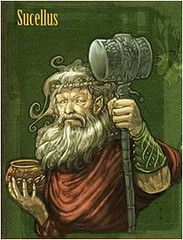
Sucellus is from Gaul, and is the God of Agriculture, Forests and Alcohol. He is depicted carrying a beer barrel on a pole. In addition to Gaul, he’s also a part of Lusitanian mythology.
Holiday: Lucaria (Commemorates the day of defeat of the Roman army by the Gauls in 390 BCE), July 19 & 21
Links: Deities Daily / Godchecker / Wikipedia
- Sucellus: Gaulish God of Alcohol
-
- Taliesin: Celtic God of Barley
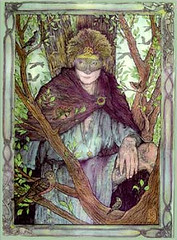
A minor Welsh god, who was worshipped through the 16th century. He was a god of fertility and barley.
Holiday: Day of Taliesin, April 29; Domhnach Chrom Dubh, June 28
Links: Godchecker / Wikipedia
- Taliesin: Celtic God of Barley
-
- Tenenit: Egyptian Goddess of Beer
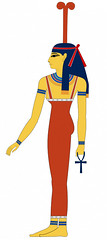
Though little is known about Tenenit, she was the Egyptian Goddess of Beer, and appears in the Book of the Dead and texts during the Ptolemaic period, which was from 305 to 30 BCE. It’s sometimes spelled Tenenet, Tjenenet, Zenenet or Tanenet. Tenenit was also a goddess of childbirth, and as such is usually associated with Isis, the goddess of motherhood and fertility.
Holiday: Festival of Isis, January 7; Opet Festival (Marriage of Isis and Osiris, with a party thrown afterwards by Tenenit), July 19.
Links: Ancient Egypt Online / Wikipedia
- Tenenit: Egyptian Goddess of Beer
-
- Tequechmecauiani: Aztec God of Drinking
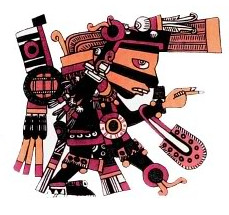
Tequechmecauiani was an Aztec God of Drinking. According to the Popol Vuh, “Tequechmecauiani was a drink-god to whom it was necessary to sacrifice, if one wished to avoid suicide by hanging during intoxication.” He is also believed to be one of the Four Hundred Drunken Rabbit Gods, known as the Centzon-Totochtin.
Holiday: Centzon-Totochtin Drunken Rabbit Day, Last Saturday in September (28th in 2013); Rabbit Rabbit Day, Last Day of Each Month
Links: Godchecker / Mythology Dictionary
- Tequechmecauiani: Aztec God of Drinking
-
- Tezcatzontecatl: Aztec Beer God
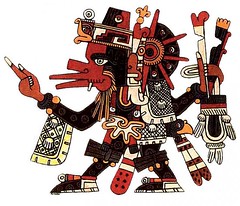
Tezcatzontecatl was the Aztec Beer God. More properly, he was the God of Pulque, which was a traditional alcoholic beverage that was similar to beer, made by fermenting the juice of the century plant. But more broadly, he was also a god of intoxication or drunkenness and also fertility. He is also believed to be one of the Four Hundred Drunken Rabbit Gods, known as the Centzon-Totochtin.
Holiday: Festival of BBQ & Pulque (Festival de la Barbacoa y el Pulque, Puebla, Mexico), July 23; Centzon-Totochtin Drunken Rabbit Day, Last Saturday in September (28th in 2013); Festival of Tezcatzontecatl, September 29; Rabbit Rabbit Day, Last Day of Each Month
Links: Godchecker / Wikipedia
- Tezcatzontecatl: Aztec Beer God
-
- Thor: Norse God of Thunder
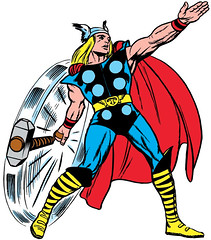
In Norse mythology, Thor is the god of thunder and the second most important after his father, the god Odin. The name Thor means thunder, and he is the ruler of storms and lightning. Thor’s hammer — Mjölnir — which he also used for plowing and crop improvement. Thor is also known for his love of beer. According to one legend, thunder roared when Thor was cleaning a huge boiler after the gods brewed beer, and the sky was overcast and full of clouds. People believed that the powerful suction of beer coming in and going out of the gods’ brewery leads to fluctuations in sea level, which causes the tides.
Holiday: Mjölnir (Old Germany; Celebration of Thor’s Hammer), May 20; Thor’s Day, July 29 and December 6
Links: Godchecker / Wikipedia
- Thor: Norse God of Thunder
-
- Vulcan: Roman Blacksmith God & Brewer; See Hephaestus.
-
- The Wave Maidens: Aegir’s Nine Daughters & Assistant Brewers
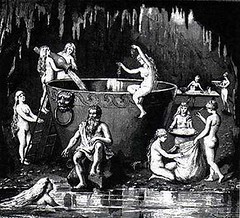
The Wave Maidens are the nine daughters of Aegir, the Norse God of the Sea, who was also the brewer to the Gods of Asgard. His daughters each have their own aspects, too. They were Himinglæva (That through which one can see the heavens, a reference to the transparency of water), Dúfa (The Pitching One), Blódughadda (Bloody-Hair, a reference to red sea foam), Hefring (Riser), Udr (Frothing Wave), Hrönn (Welling Wave), Bylgja (Billow), Dröfn (Foam-Fleck) and Kólga (Cool Wave). According to Journeying of the Goddess; “They were portrayed as beautiful maidens dressed in white robes and veils and always helped their father, brew the beer for the gods.”
Holiday: Celtic Sea Festival, March 3
Links: Godchecker / Wikipedia
- The Wave Maidens: Aegir’s Nine Daughters & Assistant Brewers
-
- Water Gods: God & Goddesses of the Ocean, Rivers and Water
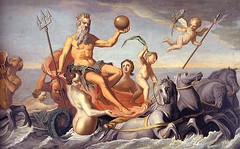
The ancient world is filled with gods and goddesses associated with water. The most obvious is probably Poseidon, the greek god of the sea, and his Roman counterpart, Neptune, but there are numerous others. In addition to the sea, there were deities for lakes, rivers, springs, rain, fresh water and simply the god, or goddess, of water. The Greeks alone, had dozens of water gods. Given the importance of water to life, it’s probably not too surprising that this is the case. And as important as water is to the brewing of beer, few deities specify that they rule over specifically brewing water, so I didn’t want to just list every water deity here, especially not the ones associated with saltwater or the oceans. So apart from Aegir, Arnemetia, Enki, Hapi and Icovellauna, whose legends do mention some association with beer, I haven’t listed any others, even though a case could be made that water gods are all beer gods, too, since water is such an important component to brewing. There’s a few links below with lists of water deities and a good one about the panoply of water mythology.
Links: Bullfinch’s Mythology / Temple of Sedna / Water Mythology / White Rose Gardens / Wikipedia
- Water Gods: God & Goddesses of the Ocean, Rivers and Water
-
- Yasigi: Mali Goddess of Beer
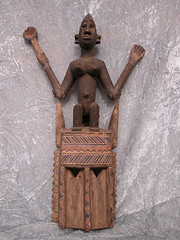
To the Dogon people of Mali, Yasigi was the Goddess of Dancing, Beer and Masks. She’s usually depicted as a large-breasted female dancing while holding a beer ladle in one hand. According to one account.A goddess of the Dogon people residing in Western Africa, Yasigi was born from the Kinder Egg of the supreme creator god Amma and hidden away from her evil twin brother. It’s a good thing, since she managed to grow up to affiliate herself with fun stuff, like beer, dancing and masks. Masks were important to this culture since they represented the gods and ancestors that were used in ceremonial dances that were fueled with beer. Yasigi herself would preside over the most significant ritual, the Sigi ceremony that was held every 60 years and would last 7 years in duration by transferring from one village to another. Affectionately called the sister of the masks, she showed humanity how to brew beer for the first Sigi ritual, and even cultured the red hibiscus plant for the mask dancers to make their skirts out of.
Holiday: Bulo Festival, May 15; Sigi ceremony, held every 60 years, and lasting for 7 weeks, the next will take place in 2027
Links: Godchecker / Wikipedia
- Yasigi: Mali Goddess of Beer
-
- Yeast Spirits: Various Cultural Spirits of Yeast

While there’s no specific god or goddess of yeast, several cultures have recognized a spirit at work in their fermentation. Here’s some examples excerpted from The Yeast of the Ancients:Ancient Norwegian terms for this substance are suggestive of how it was thought of — its meaning: gjar — working, gjester — foaming, berm — boiling, kveik — a brood that renews a race, nore — to kindle a fire, bryggjemann — brewing man, and fro — seed. All the terms are suggestive: there is a boiling, a fire being kindled, a new race being born. The commonness of terms associated with burning, boiling, and kindling a fire, for instance, are interesting. Yeast works through a rapid oxidation of the sugar, a kind of burning. And when they are their most active the brew, the wort, actually bubbles energetically. And this association is clearly a part of older terms for yeast. A term meaning “boiling” is used throughout the world. And when preserved yeast is added to new batches of beer, it is a brood renewing a race that has been dormant (and it is interesting that kveik comes from the same root word as kvaser — the Nordic being from whose blood the original beer, the “mead of inspiration,” was made).
The Charoti of South America view the moment of yeast activity as “the birth of the good spirit” in the wort. But the Charoti say that there are many bad spirits that will try and prevent this birth. So they sing and play musical instruments while exhorting the fermentation to begin. Once the good spirit enters the wort, they say, it is powerful enough to stop any bad spirits from getting into the beer. Throughout the ceremony of encouraging the good spirit to enter and begin fermentation the Charoti singers keep their attention focused on the essence of the good spirit, calling its intelligence into awakening, urging it to hear their call, exhorting it to come to them and settle into the home they have prepared for it. Hearing this without prejudice and comparing it to the perspectives of Western brewers, it is not so very different. We wish only one yeast, the good one, to come and ferment our beer. And we take steps to prevent the bad ones from getting there first. We know, too, that once the good yeast is in the wort, it is very difficult for a bad one to gain entry. We place our emphasis on sterility and using store-bought yeast. But those cultures who depend on wild yeasts use prayer to influence its appearance. Though superstitious to our Western way of thinking what is truly surprising is not only the prevalence of this belief among the world’s peoples but the effectiveness of the brewing based on it.
Similarly, the Ainu/Japanese goddess Kamui Fuchi uses mugwort to frighten away bad spirits. “In making their rice and millet beer, prayers and offerings to Kamui Fuchi, hearth goddess and guardian spirit to protect from bad spirits.”
Links: The Yeast of the Ancients / Wikipedia
- Yeast Spirits: Various Cultural Spirits of Yeast
-
- Yi-Di: Chinese Goddess of Alcohol

Yi-Di, sometimes Yi-Ti, was the Chinese Goddess of Alcohol. She was originally human, though, and created the perfect brew, made from rice, in the 23rd century BCE. After presenting it to Emperor Yu—who loved the strong brew—it was banned because the Emperor feared future rulers, and society in general, would not be able to hold their liquor like he could and the world might fall apart. Yi-Di continued to make her divine rice beer and later achieved the status of a Goddess. - Other accounts claim she was either wife or consort of Emperor Yu, and still others say it was not banned, but instead the “king liked it so much that he decreed that future generations should be able to enjoy it for time immemorial.” One account even claims that Yi-Di was the Emperor’s daughter. It’s hard to find a definitive story of Yi-Di, and what has down through history tends to vary quite a bit.
Holiday: Duanwu Festival 端午節 / 端午节 (or Dragon Boat Festival), 5th Day of the 5th Lunar Month, June 12, in 2013; Mid-Autumn Festival 中秋節 / 中秋节 (or Moon Festival), 15th Day of the 8th Lunar Month, September 19, in 2013
Links: Godchecker / Wikipedia / Chinese Alcohol, Chinese Spirits / A Brief History of Baijiu
- Yi-Di: Chinese Goddess of Alcohol
By Feast Days or Festivals Relating to Beer Gods & Goddesses*
- January 1: Dabucuri assaby, Initiation Rites of the Young Men (Jurupari, South American Guarani/Tupi God)
- January 2: Birthday of Inanna (Sumerian Goddess and Patroness of Tavern Keepers)
- January 4, in 2014 (1st Saturday of each month): Satyr’s Day (Silenus, Greek God of Beer Buddies and Drinking Companions)
- January 5: Festival of Kore (Persephone, Greek Goddess of Vegetation)
- January 7: Festival of Isis (Tenenit, Egyptian Goddess of Beer)
- January 12: Anthesteria (Dionysus, Greek God of Intoxication)
- January 12: Feast of Fabulous Wild Men (Enkidu, Mesopotamian Wild Man character in the Epic of Gilgamesh)
- January 20: Festival of Jubilation for Osiris (Egyptian God of Agriculture)
- January 23: Day of Hathor (Egyptian Goddess of Drunkenness)
- January 24: Sementivae begins (Ancient Roman festival honoring Ceres (Goddess of Agriculture) and Tellus (Ceres, Roman Goddess of Agriculture & Grain Crops)
- February 1: Imbolc, Feast of Brigid (The Dagda, Celtic God of the Earth & All-Father)
- February 1: Lenaia (Festival of Drama to Dionysus, Greek God of Intoxication)
- February 1, in 2014 (1st Saturday of each month): Satyr’s Day (Silenus, Greek God of Beer Buddies and Drinking Companions)
- February 2: Dabucuri ucuqui, Initiation Rites of the Young Men (Jurupari, South American Guarani/Tupi God)
- February 12: Choes Day (Day of the Cups; Ancient Greece)
- February 14: Zadoushnitza, Bulgarian All-Souls’ Day (Κυρμιληνός, Balkan Celts God of Beer)
- February 28: Kalevala Day (The Finnish Origins of Beer)
- March 1 (in 2014; Saturday before Ash Wednesday): Carnaval de Barranquilla (a.k.a. Barranquilla’s Carnival; Chibcha (Colombian) Goddess of Drinking, Dancing and Merry-Making)
- March 1, in 2014 (1st Saturday of each month): Satyr’s Day (Silenus, Greek God of Beer Buddies and Drinking Companions)
- March 2: Icovellauna Water Festival (Ouranian God of Ale Brewing)
- March 3: Celtic Sea Festival to Aegir (Norse Brewer to the Gods of Asgard)
- March 3: Dabucuri mirtis, Initiation Rites of the Young Men (Jurupari, South American Guarani/Tupi God)
- March 12: End of the World by Sekhmet (Egyptian Warrior Goddess)
- March 15: Feast of Bacchus (Roman God of Intoxication)
- March 15: Marduk’s Festival (Babylonian Beer-Brewing God)
- March 18: Goddess of Fertility Day (Mbaba-Mwanna-Waresa, Zulu Goddess of Beer & Fertility)
- March 20 (Vernal Equinox): Dísablót (Norse Female Ghost, Spirit or Deity Associated with Fate)
- March 20: Mesopotamian/Sumerian Grain Festival (Honoring Ashnan, Mesopotamian Goddess of Grain; Ninlil, Sumerian Goddess of the Grain; Nunbarsegunu, Sumerian Goddess of Barley)
- March 21: Akitu (Mesopotamian spring festival, “cutting of the barley,” celebrating Marduk’s victory over Tiamat)
- March 21: Dionysia (Dionysus, Greek God of Intoxication)
- March 21: Festival of Kore and Demeter (Greek Barley Mother Goddess)
- March 27: Barley Harvest Festival (Jehovah, Protector of the Barley)
- March 27: Birthday of Michael Jackson (God of Beer Writers)
- March 29: Back to Babylon Procession & Banquet (Nin-Anna, Babylonian Goddess of Beer)
- March 30: Celebration of the Marriage of Inanna and Dumuzi (Day 10 of Akitu)
- April 1: April Fool’s Day (Belgian Beer Spirits)
- April 1: Festival of Renenutet/Birthday of Neper (Egyptian God of Grain)
- April 1: Hathor’s Day (Egyptian Goddess of Drunkenness)
- April 2: Feast of Acan (Mayan God of Alcohol)
- April 2-7 (Week after Easter): Féile Pan Cheilteach or Pan Celtic Festival (The Dagda, Celtic God of the Earth & All-Father)
- April 3: Find A Rainbow Day (Mbaba-Mwanna-Waresa, Zulu Goddess of Beer & Rainbows)
- April 5, in 2014 (1st Saturday of each month): Satyr’s Day (Silenus, Greek God of Beer Buddies and Drinking Companions)
- April 11: Birthday of Gambrinus (Gambrinus, Flemish King of Beer)
- April 13-16: Thingyan Festival, Burmese New Year (Min Kyawzwa, Burmese God of Drinking)
- April 18, in 2014; Good Friday [Friday before Easter]: Festival of Dagon (Phoenician God of Wheat & Grain)
- April 19: Cerealia (Ceres, Roman Goddess of Agriculture & Grain Crops)
- April 21: Festival of Sacred Groves (Arnemetia, Celtic River Goddess)
- April 23: Feast of Hephaestus (Greek Blacksmith God & Brewer)
- April 23: Jorė (Perkūnas, Latvian God of Thunder)
- April 29: Day of Taliesin (Taliesin, Celtic God of Barley)
- April 30-May 1: Beltane (Medb, Irish Goddess of Intoxication)
- April 30: Vappu (Pekko, Estonian & Finnish God of Fields and Crops)
- April 30: Yakima Tribe Root Festival (Native American)
- May 1: Mati-Syra-Zemlya Pregnancy Day (Mati-Syra-Zemlya, Slavic Goddess of the Earth)
- May 3, in 2014 (1st Saturday of each month): Satyr’s Day (Silenus, Greek God of Beer Buddies and Drinking Companions)
- May 4-6, in 2013: Clun Green Man Festival (Celtic God or Spirit of Nature)
- May 4: Dabucuri pataub, Initiation Rites of the Young Men (Jurupari, South American Guarani/Tupi God)
- May 13: Leprechaun Day (Cluricane, Irish Spirit or Elf)
- May 15: Bulo Festival (Yasigi, Mali Goddess of Beer)
- May 20: Mjollnir (Old Germany; Celebration of Thor’s Hammer) (Norse God of Thunder)
- May 21: Festival of Demeter (Greek Barley Mother Goddess)
- May 25: Africa Day (Khuzwane, An African God of Beer)
- May 27: Feast of Comus (Greek God of Drunken Revelry).
- May 29: Ambarvailia,Old Roman No Work Day, Purification Festival to Ceres, (Roman Goddess of Agriculture & Grain Crops)
- June 7-8, in 2013 (begins last Friday): Haku Päällä Rakkausfestivaali, Kutemajarvi Sex Festival & Matchmaking Festival (Pekko, Finnish God of Fields and Crops)
- June 7, in 2014 (1st Saturday of each month): Satyr’s Day (Silenus, Greek God of Beer Buddies and Drinking Companions)
- June 8, in 2014 (Whitsunday; 7th Sunday after Easter): Rusalii (Pereplut, Slavic Goddess of Drinking)
- June 11: Holiday of the Happy Gnomes (Belgian Beer Spirits)
- June 12, in 2013 (5th Day of 5th Lunar Month: Duanwu Festival 端午節 / 端午节 or Dragon Boat Festival (Yi-Di, Chinese God of Alcohol)
- June 20: Day of Cerridwen and Her Cauldron (Welsh Goddess of Barley)
- June 23: Līgo (Cerklicing, Latvian God of Farm Fertility and Crop Abundance)
- June 24: Inti Raymi (Incan Festival of the Sun) (Accla, female keepers of the sacred fires, who also brewed beer)
- June 24: Midsummer’s Day (John Barleycorn, English Personification of Barley)
- June 24: Zemlya’s Night (Mati-Syra-Zemlya, Slavic Goddess of the Earth)
- June 28: Domhnach Chrom Dubh (Taliesin, Celtic God of Barley)
- June 30-July 2: Aizen Festival, Osaka, Japan (Aizen Myō’ō, Japanese God of Tavern Keepers)
- July 1 (1st Monday): Feast of Habondia (Habonde, Welsh Goddess of Abundance)
- July 3: Festival of Cerridwen (Welsh Goddess of Barley)
- July 4-5, in 2014 (begins 1st Friday): Eukonkanto, Finnish Wife Carrying Contest (Pekko, Finnish God of Fields and Crops)
- July 5: Dabucuri umari, Initiation Rites of the Young Men (Jurupari, South American Guarani/Tupi God)
- July 5, in 2014 (1st Saturday of each month): Satyr’s Day (Silenus, Greek God of Beer Buddies and Drinking Companions)
- July 7: Fledh Ghoibhnenn (Feast of Goibhniu, Celtic Brewer of the “Beer of Immortality”).
- July 11: Feast of Min Harvest & Fertility Festival (Min, Egyptian God of Fertility)
- July 12, in 2014 (2nd Saturday): Bon Odori, Japanese Festival of the Lanterns (Kirin, Mythical Asian Unicorn)
- July 12-13, in 2014 (2nd weekend in July): Lindenfest (Minne, German Goddess of Love and Fertility)
- July 14: Birthday of Osiris (Egyptian God of Agriculture)
- July 18: Nebet-Het (Birthday of Nephthys, Egyptian Goddess of Beer)
- July 19: Lucaria, Day 1 (Sucellus, Gaulish God of Alcohol)
- July 19: Opet Festival (Tenenit, Egyptian Goddess of Beer)
- July 20 (2013): Pilton Green Man Festival, England (Celtic God or Spirit of Nature)
- July 21: Lucaria, Day 2 (Sucellus, Gaulish God of Alcohol)
- July 23: Festival of BBQ & Pulque, Puebla, Mexico (Tezcatzontecatl, Aztec Beer God)
- July 26: Green Corn Festival (Onatha, Iroquois Spirit of Wheat)
- July 27, in 2014 (4th Sunday in July): Domhnach Chrom Dubh Irish Grain Festival (Irish Underworld Grain or Corn God)
- July 27: Feast of Hanseath (Dwarven God of Alcohol, Dungeons & Dragons)
- July 27, in 2014 (4th Sunday in July, but begins Saturday night before): Tsushima Tennoo Matsuri 津島天王祭り Shōjō Festival (Japanese Drunken Sea Spirit)
- July 27-28, in 2013 (Last Weekend): Ganondagan’s Spirit Dancers/Iroquois Social Dancing Festival (Onatha, Iroquois Spirit of Wheat)
- July 28 (in 2014): Ba-Maguje’s Day (Hausa Spirit of Drunkenness; held on Eid al-Fitr)
- July 31-August 1 (Sunset): Lughnasadh Grain Harvest Festival (John Barleycorn, English Personification of Barley)
- August 1, in 2013 (25th Day of the Sixth Lunar Month): Birthday of Lan-Caihe, (Lan-Caihe, Chinese Drunken Eight-Immortal)
- August 1: Festival of Albina (a.k.a. Alphito, the White Barley Goddess)
- August/September: Kull Gossaih Corn Festival (Kull Gossaih, Indian Goddess of Grain)
- August 1: Lammas Grain Harvest Festival (John Barleycorn, English Personification of Barley)
- August 1-3: Makaveyan Days (Κυρμιληνός, Balkan Celts God of Beer)
- August 1: Mati-Syra-Zemlya Day (Mati-Syra-Zemlya, Slavic Goddess of the Earth)
- August 2-3 (1st Fri./Sat.): Moxee Hop Festival (Hoppiata, Goddess of the Hop)
- August 2, in 2014 (1st Saturday of each month): Satyr’s Day (Silenus, Greek God of Beer Buddies and Drinking Companions)
- August 3, in 2014 (1st Sunday in August): Dé Domhnaigh Crum-Dubh, a.k.a. Crom Dubh Sunday (Irish Underworld Grain or Corn God)
- August 10-11 (in 2013; 2nd Weekend in August): Coquetdale John Barleycorn Festival, England (English Personification of Barley)
- August 12: Festival of Intoxication, Day of Sekhmet’s repulsion of Set (Egyptian Warrior Goddess)
- August 15-18 (2013): Green Man Festival, Wales (Celtic God or Spirit of Nature)
- 8-Days in late August/early September: Umhlanga/Reed Dance Ceremony (Mamlambo, Zulu Goddess of Beer-makers)
- August 15: Wafaa El-Nil (Flooding of the Nile; Hapi, Egyptian Goddess of Barley)
- August 18: Gambrinus Night, Ireland (Gambrinus, Flemish King of Beer)
- August 20: Day of Inanna (Inanna, Sumerian Goddess and Patroness of Tavern Keepers)
- August 21: Consualia (Consus, Roman Protector of Grains and Storage Bins)
- August 23: Kirvis Harvest Festival, Lithuania (Gabjauja, Lithuanian Goddess of Grain)
- August 23: Umhlanga Day, Swaziland (Mamlambo, Zulu Goddess of Beer-makers)
- August 23: Vulcanalia, a.k.a. Festival of Vulcan and the Nymphs (Vulcan, Greek Blacksmith God & Brewer)
- August 24: Gunnlöð Festival (Norse Giantess)
- August 24: Mundus Patet (Roman harvest feast involving the dead, 1 of 3)
- August 25-31, in 2013 (Last Week): Kuste Karneval, a.k.a. Coast Carnival or KüsKa (Shadipinyi, Namibian God of Beer)
- August 28: Nativity of Nephthys (Egyptian Goddess of Beer)
- August 29: Feast of Agios Ioannis (Halki, Hittitie God of Grain)
- August 29: Nativity of Hathor (Egyptian Goddess of Drunkenness)
- July 29: Thor’s Day (Norse God of Thunder)
- August 31-Sep. 1 (begins on Last Saturday): Iroquois Indian Festival (Onatha, Iroquois Spirit of Wheat)
- September 2: Feast of Osiris (Egyptian God of Agriculture)
- September 7, in 2013 (1st Saturday of each month): Satyr’s Day (Silenus, Greek God of Beer Buddies and Drinking Companions)
- September 12, in 2013 (8th Day of the 8th Lunar Month): Feast of Eight Immortal Drinkers (Chinese Epic Poem).
- September 14, in 2013 (2nd Saturday): Thirsty Troll Brew Fest, Wisconsin (Belgian Beer Spirits)
- September 17: Feast of Het-Hert (Hathor, Egyptian Goddess of Drunkenness)
- September 18: Feast of Ceres (Roman Goddess of Agriculture & Grain Crops)
- September 19, in 2013 (15th Day of 8th Lunar Month): Mid-Autumn Festival (Moon Festival) (Yi-Di, Chinese God of Alcohol)
- September 19-21, in 2014 (every 3 years, Fri.-Sun., 3rd Weekend): Poperinge Beer & Hop Festival, Belgium (Hoppiata, Goddess of the Hop)
- September 22 (Autumnal Equinox): Alban Elfed (Amaethon, Welsh God of Agriculture)
- September 22 (Autumnal Equinox): Day of Perkūnas (Latvian God of Thunder)
- September 22, in 2013 (Autumnal Equinox): Festival of Ragutiene and Ragutis (Slavic Goddess & God of Beer)
- September 22: International Festival of Fire Sculptures, Lithuania (Gabjauja, Lithuanian Goddess of Grain)
- September 23: Festival of the Goddess Ninkasi (Sumerian Goddess of Brewing)
- September 28: Centzon-Totochtin Drunken Rabbit Day (Aztec 400 Drunken Rabbit Gods) [Last Saturday]
- September 29: Feast of Tezcatzontecatl (Tezcatzontecatl, Aztec Beer God)
- October 1: Oschophoria (Autumn Dionysus Festival, Greek God of Intoxication)
- October 4: Feast of Hathor (Egyptian Goddess of Drunkenness)
- October 5: Mundus Patet (Roman harvest feast involving the dead, 2 of 3)
- October 5, in 2013 (1st Saturday of each month): Satyr’s Day (Silenus, Greek God of Beer Buddies and Drinking Companions)
- October 5, in 2013 (1st Saturday): Yakima Fresh Hop Ale Festival (Hoppiata, Goddess of the Hop)
- October 7: Sumerian New Year (Mami, Sumerian Goddess of Drunkenness; Ninlil, Sumerian Goddess of the Grain; Nunbarsegunu, Sumerian Goddess of Barley)
- October 12 (in 2014; 2nd Sunday in October): Shojo Festival at Narumi Hachimangu, Nagoya, Japan (Japanese Drunken Sea Spirit)
- October 20: Ebisu Festival (Japanese God of Fortune)
- October 21: Day of Cerridwen (Welsh Goddess of Barley)
- October 25-27: Thesmophoria (honoring the goddesses Demeter and her daughter Persephone; originally held 11-13 Pyanepsion)
- October 26: Hathor’s Moon Festival (Affiliation)
- October 31-November 1: Samhain (Seonaidh, Scottish God of Ale)
- November 2: Dia de Finados, a.k.a. Day of the Dead; Brazil (Tupari Spirit of the Underworld)
- November 2, in 2013 (1st Saturday of each month): Satyr’s Day (Silenus, Greek God of Beer Buddies and Drinking Companions)
- November 3: Japanese Culture Day, a.k.a. Bunka no hi (Kirin, Mythical Asian Unicorn)
- November 5: Colon Day, Panama (Ibeorgan, Panamanian Father of Beer)
- November 6: Dabucuri uiga, Initiation Rites of the Young Men (Jurupari, South American Guarani/Tupi God)
- November 8: Festival of Hettsui No Kami of the Hearth (Kamui Fuchi, Japanese Goddess of the Hearth)
- November 8: Mundus Patet (Roman harvest feast involving the dead, 3 of 3)
- Mid-November/Early December: Chitariah Gossaih Thanksgiving (Kull Gossaih, Indian Goddess of Grain)
- November 20: Day of Sekhmet and the Purifying Flame (Egyptian Warrior Goddess)
- November 23 (in 2013): Bhairava Ashtami (Bhairava, Indian God of Soma)
- November 24: Brumalia (Roman Feast of Bacchus)
- November 24: Day of Offerings to Sekhmet (Egyptian Warrior Goddess)
- November 25: Persephone’s Day (Greek Goddess of Vegetation)
- November 28-29: Sekhmet Days (Egyptian Warrior Goddess)
- December 6: Thor’s Day (Norse God of Thunder)
- December 7, in 2013 (1st Saturday of each month): Satyr’s Day (Silenus, Greek God of Beer Buddies and Drinking Companions)
- December 12: Feast of Rekereke (Polynesian God of Pleasure)
- December 14: Byggvir Grain Festival (Norse God of Barley)
- December 15: Consualia (Consus, Roman Protector of Grains and Storage Bins)
- December 16: Festival of the Little Heat (Bes, Egyptian Protector of the Home)
- December 23: Festival of the Great Heat, Feast Day of Hathor (Egyptian Goddess of Drunkenness)
- December 24: Badnja Vece (Semargl, Slavic God of Barley)
- December 27: Kobold Luring Day (Biersal, Germanic Kobold of the Beer Cellar)
- December 31: Guinness founded (The Dagda, Celtic God of the Earth & All-Father)
- December 31: Lucky Day of Sekhmet (Egyptian Warrior Goddess)
- Last Day of Each Month: Rabbit Rabbit Day
(Centzon-Totochtin, Aztec 400 Drunken Rabbit Gods) - 2027 (takes place every 60 years, lasts 7 weeks): Sigi ceremony (Yasigi, Mali Goddess of Beer)
*NOTE: Happily, many of the dates listed above are in fact accurate and were found through diligent research. A few, however, I had to piece together from what little I could find. This was further confounded by the fact that most ancient civilizations didn’t use our Gregorian calendar or even keep accurate records about when festivals or other celebrations took place. Some were simply “at harvest time” or in the spring, or some other vague day. In those cases, I made a command decision to fix a date that made sense. A conceit? Perhaps, but since the idea is simply to celebrate these ancient gods, goddesses and spirits who are related to brewing, I felt I should fix a date. I tried my best to choose dates that seemed to fit each god or goddess. If you know of a better one, or better still, an actual one with sources you can send me, that would be even better. Cheers.
